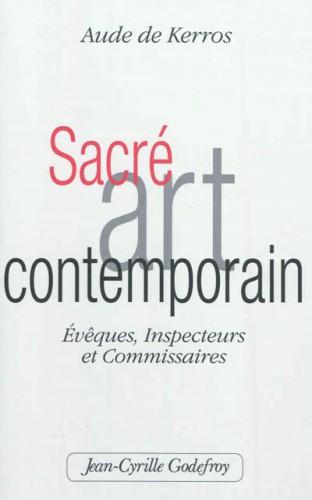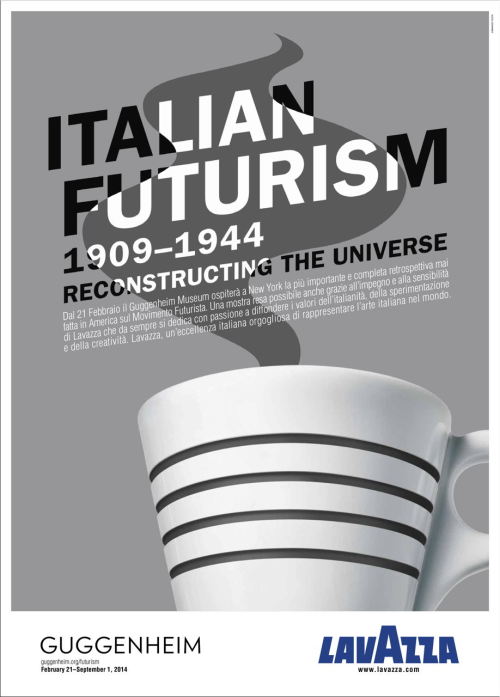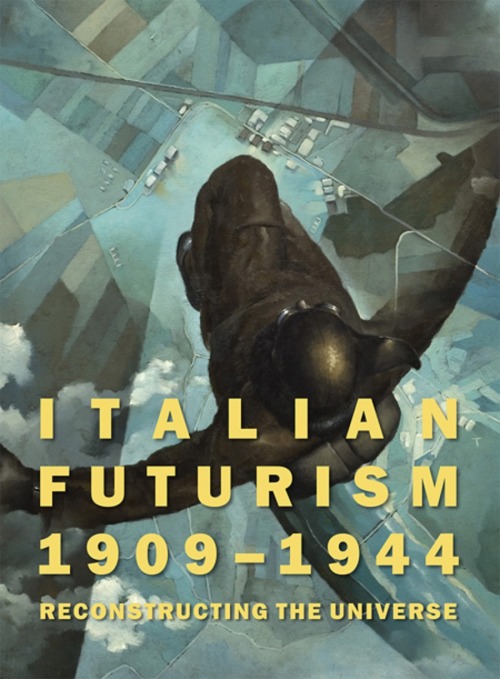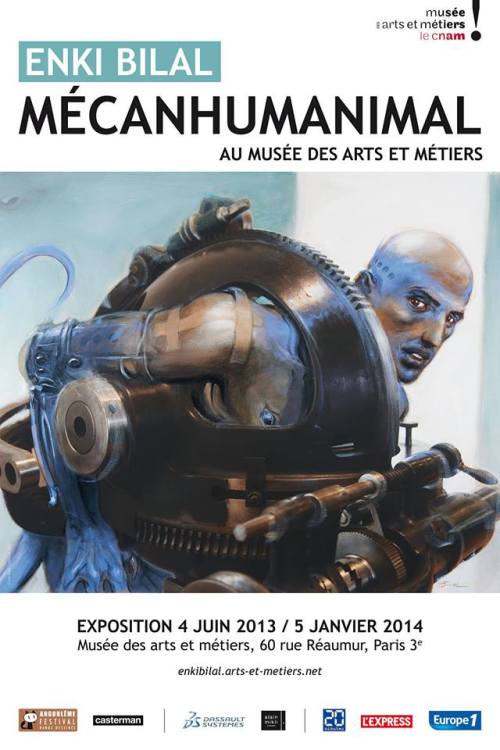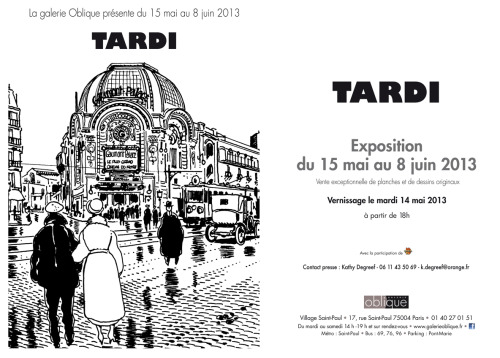mardi, 01 avril 2014
Art contemporain et Etat culturel...

Art contemporain et Etat culturel...
Ex: http://metapoinfos.hautetfort.com
Nous reproduisons ci-dessous un entretien avec Aude de Kerros, cueilli sur Contrepoint et consacré à l'art contemporain, un "art" très largement subventionné en France...
Aude de Kerros est l'auteur de plusieurs essais consacré à la question de l'art, comme L'art caché - Les dissidents de l'art contemporain (Eyrolles, 2007), Sacré Art Contemporain (Jean-Cyrille Godefroy, 2012) ou 1983-2013 Années noires de la peinture (Pierre-Guillaume de Roux, 2013), avec Marie Sallantin et Pierre-Marie Ziegler.
Aude De Kerros : « L’Etat culturel a détruit la création française »
Qu’est-ce que l’art contemporain ? Quelle est sa caractéristique principale ?
L’art contemporain est une forme de création centrée, contrairement à l’art, sur le concept. Depuis les années 60 il a connu plusieurs métamorphoses Aujourd’hui l’AC veut être une expression de la mondialisation. Pour cela il doit être hyper-visible et rentable. Ainsi l’artiste d’AC1 est devenu un concepteur d’objets, mis en forme par des designers, fabriqués en « factory », sous différents formats et en nombres adaptés aux stratégies de diffusion. Ces objets sont conçus pour habiter tous les circuits de consécration, de l’espace urbain au musée et à la galerie. Cette adaptabilité à chaque lieu assure sa visibilité et sa vente. L’objet destiné aux Institutions et au grand collectionneur rapporte souvent moins que la vente de tous les produits dérivés et des droits sur l’image. Aujourd’hui l’AC fonctionne comme un produit financier composite, fondé sur un produit manufacturé sur mesure. Ce produit financier voit fabriquer sa valeur en réseau dont le centre est le grand collectionneur et ses amis. Ce système fonctionne comme un trust et une entente réunis. Il satellise marchands, salle des ventes, institutions et médias. Son privilège sur les autres marchés financiers est de ne pas être régulé.
Sur quelles structures repose l’art contemporain ?
La consécration de « l’art » se faisait lentement par la reconnaissance des pairs, des amateurs et d’un marchand. « L’art contemporain » a changé la donne, sa valorisation se fait en réseau. Au début des années 60, la consécration devient rapide grâce à des réseaux centrés autour de grandes galeries qui lancent un nom en deux ans. A partir de la fin des années 90 c’est autour des grands collectionneurs que se fabrique la valeur, cette fois-ci en réseau fermé. Il faut y appartenir pour collectionner sans risques mais pour ce faire il faut une fortune hors normes. Le marché de l’AC comprend un deuxième cercle de « suiveurs », collectionneurs solitaires qui ont les moyens de « se faire plaisir ». Ils se veulent découvreurs, à leurs risques et périls d’artistes « émergeants » encore accessibles parce que non cooptés par le premier cercle. Grâce à cela, ils côtoient le monde prestigieux des grandes fortunes internationales. Certains manifestent ainsi leur candidature à entrer dans la cour des grands.
Le troisième cercle, celui des « innocents » appartiennent à ceux qui croient en l’AC comme on croit à une religion. Ils pratiquent le culte en achetant l’œuvre d’artistes candidats à l’émergence.
Comment expliquer que c’est l’art contemporain qui est devenu cette clé d’accès ? Qu’est-ce qui le caractérise ?
C’est un art visuel accessible au-delà des langues et des cultures car il a adopté les images de la grande consommation culturelle, dite « mainstream ». L’AC a capté les codes des marques internationales, du pop, de toutes les représentations partagées d’un bout de la planète à l’autre. L’AC acquiert ainsi un pouvoir fédérateur grâce à ce langage minimum, non verbal. C’est une communion dans le presque rien. Son contenu est souvent critique, nihiliste et dérisoire, il permet un consensus négatif et passe ainsi par dessus les obstacles liés à la foi religieuse, aux goûts culturels, à l’attachement national, aux convictions intellectuelles et politiques.
Mais pourquoi ce réseau s’est-il structuré autour d’un art ? Après tout, les associations de riches ne sont pas récentes…
Après la chute du mur de Berlin et la fin de la guerre froide culturelle, l’AC a été « reprogrammé ». Il est devenu à la fois produit financier, industrie culturelle, divertissement planétaire. Il a été le prétexte le plus adapté d’évènements et de fêtes destinées à une hyper-classe internationale liée par des intérêts d’argent. Lieux de rencontre aux quatre coins du monde, occasions périodiques, sans qu’aucune idée commune ne soit nécessaire à partager… Quoi rêver de mieux ? En résumé l’art contemporain, c’est le réseau social des très riches.
Pour autant, lorsque l’on regarde la nouvelle génération d’entrepreneurs (Marc Zuckerberg, Elon, Musk, Richard Bronson, Jeff Bezos et en France Xavier Niel), semble-t-elle répondre aux mêmes codes comportementaux ? N’y a-t-il pas chez eux un rejet de ce type de réseau ?
Il m’est difficile de juger ces personnes, il faudrait que je les connaisse mieux. Cependant je constate que l’hégémonie culturelle américaine en vigueur depuis la chute du mur de Berlin, se trouve confrontée à une résistance de plus en plus forte de la part des pays émergents qui ont l’ambition de développer leur singularité culturelle. Si l’Amérique défend « le multiculturalisme dans tous les pays », les pays qui ont les moyens financiers souhaitent créer leurs propres industries culturelles et exprimer leur identité sur leur propre sol et rayonner au-delà en particulier auprès des pays du même « bassin culturel ».
Dans votre livre vous expliquez qu’il y a un problème spécifiquement français. Pouvez-vous nous expliquer ce dont il s’agit ?
Marie Sallantin, Pierre Marie Ziegler et moi-même avons décrit, dans « 1983-2013 – Les Années Noires de la Peinture – Une mise à mort bureaucratique ? » 2, le système si particulier qui régit l’art en France. Nous avons évoqué avec précision le domaine des arts plastiques mais il n’en demeure pas moins que l’interventionnisme radical est aussi appliqué dans les autres domaines de l’art.
La situation actuelle est le résultat d’une longue histoire qui a mis la France au cœur de la guerre froide culturelle après la 2ème guerre mondiale. Son pouvoir de référence et son prestige devaient disparaître au profit des deux grandes puissances en conflit. L’Amérique a gagné cette guerre en faisant de New York la place de consécration financière de l’art dans le monde et en rendant obsolète toute autre forme de consécration.
En France à partir de 1983, le Ministère de la Culture se transforme en Ministère de la création. En l’espace de trois mois sont créées des institutions bureaucratiques dotées d’un budget conséquent qui vont permettre l’encadrement de la vie artistique.
Pendant trente ans, cette administration, grâce à l’action d’un nouveau corps de fonctionnaires : les « inspecteurs de la création », a dit promouvoir un art d’avant-garde, révolutionnaire, d’essence conceptuelle. En réalité ces « experts » ont dépensé, pendant 30 ans, 60% du budget destiné à acheter des œuvres à des artistes vivants, à New York, dans des galeries newyorkaises, d’artistes « vivant et travaillant à New York ». Ainsi mourut la place de Paris.
Pourquoi cette exclusion de la peinture ?
La peinture, la sculpture, la gravure, ne surgissent pas de nulle part, elles sont la suite d’une longue histoire. C’est vrai de tous les lieux qui ont produit un grand art. L’exception française réside en ce que tous les moments de la peinture y ont été reçus et assimilés… un avenir de la peinture y est donc possible.
La direction étatique de la création en France, cas unique dans un Etat non totalitaire, a eu pour conséquence l’existence d’un art officiel. L’administration a fait le choix exclusif du conceptualisme et a donc rejeté de façon systématique la peinture, comme n’allant pas « dans le sens de l’Histoire ». En peu de temps l’Etat est devenu le seul réseau de consécration en France. Il a satellisé grands médias, université et quelques collectionneurs, mécènes et galeries. Ce qui est surprenant c’est que la peinture n’a pas été simplement exclue mais diabolisée. Nous en apportons la preuve dans les « Années Noires ». La conséquence a été que les marchands du secteur privé n’ont pas pu supporter la concurrence déloyale de l’Etat. L’invisibilité médiatique, la disparition des commandes et achats de l’Etat ajoutés à la condamnation officielle de la peinture ont rendu toute consécration impossible par des circuits privés.
Pour que l’art conceptuel puisse être « le seul art contemporain » il fallait que la peinture disparaisse. Pour que cela soit définitif, l’administration a interrompu la transmission du grand métier, en changeant le contenu des enseignements des Ecoles d’Art dépendant de l’Etat,
En 1983 l’Etat français a nationalisé banques et assurances mais a échoué dans sa tentative de monopole de l’éducation en raison d’un soulèvement populaire. La « nationalisation » de l’Art a eu lieu sans provoquer une telle indignation. Aujourd’hui le conformisme de droite et de gauche s’en accommode. Il est vrai que les médias ont occulté systématiquement tout débat sur ce sujet pendant trente ans (exception faite entre novembre 1996 et mai 1997). Les élites françaises sont peu intéressées par ce sujet dont ils ne comprennent pas les tenants et aboutissants et en ignorent l’Histoire.
Les banques et les sociétés d’assurance ont été re-privatisées mais l’art est resté en France un monopole d’Etat. Les « inspecteurs de la création » sont toujours là alors que les « ingénieurs des âmes » créés par Staline pour remplir les mêmes fonctions d’encadrement et de distribution de subventions ont disparu depuis un quart de siècle.
Ne voyez-vous aucun signe d’amélioration ces toutes dernières années ?
Les médias ont célébré en 2013 le trentième anniversaire des institutions culturelles crées en 1983 : trente ans d’art dirigé donc ! Ils y ont interviewé les fonctionnaires. Ceux-ci ont ajouté un zeste élégant d’autocritique. Colloques, rapports et écrits faisant un bilan critique de cette longue administration n’ont eu de visibilité que sur Internet, malgré la sollicitation qui a été faite aux grands médias d’en tenir compte où de publier dans leurs « pages débat » des points de vue plus critiques.
Ce positionnement dans le refus du débat concerne également les grands médias de droite où de gauche. De même, si la dissidence française dans le domaine de l’art a produit une critique cultivée et approfondie du système en place, c’est en dehors d’un positionnement politique. C’est un problème de liberté nécessaire à l’art.
Il y a cependant progrès puisque le débat sur l’art est aujourd’hui présent sur Internet de façon intense. Les internautes ont le choix, je citerais entre autres les sites : « Sauvons l’art », « Face à l’Art », « Les chroniques de Nicole Esterolle », « Le grain de sel » de Christine Sourgins, etc.
Le débat sur l’art est accueilli par ailleurs, à droite comme à gauche, par les différents sites d’information générale, de Médiapart à Causeur en passant par Contrepoints et tant d’autres supports représentant enfin le kaléidoscope de l’opinion française.
Aude de Kerros , propos recueillis par PLG (Contrepoint, 22 mars 2014)
Notes
1. AC, acronyme de Art contemporain employé par Christine Sourgins dans « Les Mirages de l’Art contemporain », aux Editions de la Table Ronde. Cela permet de distinguer cet art conceptuel qui se dit seul contemporain avec tout l’art d’aujourd’hui et la peinture notamment.
2. Editions Pierre Guillaume de Roux, 2013.
00:09 Publié dans art, Entretiens | Lien permanent | Commentaires (0) | Tags : art, entretien, aude de kerros, france |  |
|  del.icio.us |
del.icio.us |  |
|  Digg |
Digg | ![]() Facebook
Facebook
lundi, 31 mars 2014
Life is Always Right
Life is Always Right:
Futurism & Man in Revolt
By Mark Dyal
Ex: http://www.counter-currents.com
“We are not only more revolutionary than you, but we are beyond your revolution.” – F. T. Marinetti[1]
“You must know that blood has no value or splendor unless it has been freed from the prison of the arteries by iron or fire.” – F. T. Marinetti[2]
In the early days of July 1923, a heroic and blasphemous storm blew across the Carso plain and down into the Po river valley. Its daring speed and electrified energy created an atmosphere that transfixed those who scrambled for the safety of porticoes, sensing that this storm would put to a test all that had survived such storms in the past. Indeed, by the time it reached the flag-ringed buildings of Milan’s Piazza San Sepolcro the conflagration seemed to laugh at the memory of the structures that fell in its wake. And in that great and hallowed piazza, Giuseppe Prezzolini cowered away from the window, intent to finish the work that taxed his overwrought senses.
Prezzolini, the fine journalist and literary critic, was deep in rumination about perspective. How, he wondered, could those who sought to revolutionize the world champion something as amorphous and changing as perspective? How could revolt, of all things, proceed without the order and precision of truth and objectivity? How could the pathetic moans of an amateurish whore be confused with an ecstatic symphony of pleasure; or worse, how could the exalted battle cries of the world’s new masters be merely the cacophonous baying of a frightened herd of sheep? With this problem in mind, he tapped out his work, “Fascism and Futurism,” and thereby gave his readers a new perspective on the storm blowing through his proud and sanctified abode.
From Prezzolini’s perspective, the storm was violent and uncontrollable. It raged without memory with the instruments of war: grenades, mortars, and bombs seemed to explode in response to the piercing thrusts of rifle-bound bayonets, lashing wildly at the orderly and sensible piazza below. With every blow he shrank deeper into the comfort of his writing chair. Soon, however, a dreadful thought occurred to him, and he rushed to the window. Relieved and gratified, he smiled a knowing smile when he saw that the tattered symbols of reason, truth, and morality were still on guard against the vile anarchic forces besieging them.
From Prezzolini’s perspective, reason, truth, and morality were synonymous with the successful Revolution that had climaxed nine months earlier, bringing humanity one step closer to the perfection of liberty – a political and mystical right of men properly bound by duty and responsibility to the State.[3] Of course, much had happened in the meantime, and the soon-to-dissipate storm outside his window would be just as soon forgotten. As he remembered, Fascism and Futurism once had much in common. Especially in the days following the Great War, when Marinetti’s men led the revolutionary syndicalists, arditi, and critical artists into the fascist movement – back then they even called themselves “ardito-futuristi,” each with his own love of danger, violence, and reawakened instincts of the man of war.[4]
In they came, he remembered, crowding into the Industrial and Commercial Hall just outside his door. They were drunk on Sorel, proclaiming conflict a “permanent necessity” in the fight against a passive and flaccid existence. The failure of social revolution, one of them said, especially in the wake of industrialization and the creation of the urbanized mass man, was due to cowardice; the syndicalists just failed to act – and were ultimately betrayed by the Movement and Party crazed socialists.
This, according to Marinetti – the leader of this band of misfits, is one reason the Futurists claimed to be “mystics of action,” seeing the nation-State as a bastion of conservatism, repression, bureaucracy, and clericalism: even with neo-classical rulers, one might say, the State is and will always be the enemy of free men – men on the outside, in the beyond, in the nether regions of what is permissible and “good for business.”
As such, they would move against the State in the squadristi bands that almost became the ruin of The Revolution. Disdainful of the police, they were illegal, spontaneous, often haphazard, and arbitrary – hardly the stuff that goes into the establishment and defense of law and order!

So, this perpetually violent man in revolt, freed from moral and historical constraints and Statist duties and responsibilities, was to become the new “Futurist man:” a man, as Marinetti said, that is not human (for without the essential elements of the human – rationality, morality, and memory – all perfectly suited to justify slavish adherence to being-bourgeois – then one is no longer human, but something else – something monstrous, something rapacious, something joyous). Marinetti said that the bourgeois State corrodes vital energy, that it feeds upon humanized herd-animals with deadened wills yoked to universalized assumptions of natural goodness and happiness. But Prezzolini would ask him today as he did then, what good could this Futurist man bring to The Revolt? He is be too reckless, too free, and too dangerous to be of any use to men trying to build a State.
Squadrismo! Yes, he remembered, that’s what it was about: embodied radicalism, joyful violence, and the destruction of the forces of order that so perfectly connected mind, body, and State. Ruefully, he shook his head, eager to forget the ravages of such unchecked, unscripted, and useless virility. The Futurists’ virility – the cult of speed, the contempt for the masses, and the antipathy toward bureaucracy – had certainly infected the early days of the Fascist Revolution. But fighting to become-other, to move beyond duties and responsibilities while embracing the flux and chaosmos of the man in revolt, this is a far cry from fighting for the honor and glory of the State. In the former the heroic man will die alone, but in the other – in the fight that we men of the State promise and demand – the heroic man never dies. Instead he is made grander and more meaningful than he ever could have been on his own.
However, standing here in the afterglow of the creation of the Fascist State – the very symbol of victory! – Prezzolini began to laugh aloud at the memory of what would one day be called the creation of the “two fascisms.”[5]
But then, in the summer of 1921, it was the moment of truth for Prezzolini’s Revolt. Would it follow the disdainful revolutionary violence of the Futurists and arditi into an unknowable future? Or would it turn toward the bourgeois shopkeepers and landowners who sought a stable and prosperous State built on the foundations of a glorious national past? Would it be swept up in the unbridled action of the men in revolt, or would it become The Revolution? Would it maintain its core as a pack of elite and daring fighting men – those who dared, in fact, to cast off all bourgeois duties and responsibilities, to “cut all roots and understand nothing but the delight of danger and quotidian heroism?”[6] Or would it embrace its historical responsibility and create something lasting, something immortal, like a Party and State?
Indeed it would, and did – disposing of both the Futurists and ardito-squadristi alike in several purging acts of political rationality – and set itself up as the apotheosis of “hierarchy, tradition, and authority.”[7] But as the storm blew, and the rotary engines intoxicated with their own speed and sound blasted at the security of the paving stones below his window, Prezzolini felt uneasy, as if something violent, cruel, and beyond the strictures of justice was seeping through the cracks in his sanctified workspace.
At once he knew its source: Marinetti. Blasphemer! Madman! The fool who wanted to use violence to destabilize the subjective – and subjectifying – forces of the bourgeois form of life! And to what end? Well, Prezzolini knew quite well to what end. Look at this, he screamed to his soul as he grabbed the tear sheet:
And so, let the glad arsonists with charred fingers come! Here they are! Here they are! Go ahead! Set fire to the shelves of the libraries! Turn aside the course of the canals to flood the museums! . . . Seize your pickaxes, axes, and hammers, and tear down, pitilessly tear down the venerable cities! . . . You raise objections? Stop! Stop! We know them. We’ve understood! The refined and mendacious mind tells us that we are the summation and continuation of our ancestors – maybe! Suppose it so! But what difference does it make? We don’t want to listen![8]
And so Prezzolini wrote a serendipitous march, a pointed and reserved tome in defense of the tradition and past splendor that found itself under attack from these irresponsible derelicts. Look again, his tormented cogito demanded; they actually call themselves “barbarians – the recalcitrant defaulters of the Ideal!”[9]
“Fascism, if I am not mistaken,” he began to write, “wants hierarchy, tradition, and observance of authority. Fascism is content when it invokes Rome and the classical past. Fascism wants to stay within the lines of thought that have been traced by the great Italians and the great Italian institutions, including Catholicism. Futurism, instead, is quite the opposite of this. Futurism is a war against tradition; it is a struggle against museums, classicism, and scholastic honors. How can this be reconciled with Fascism, which instead is trying to restore all our moral values?”[10]
Thank God, he murmured. Thank God! Thank God we had the decency, the sensibility, and the duty to distance our glorious Party and State from these lunatics. Perspective had made Prezzolini wise, for he knew that revolution had no future. The future, as history had already shown, is with the State. So be it if Fascism had to become a counter-reformation that betrayed the revolutionary energies and critical vitalism of its founding members:[11] the State and nothing but the State, as Mussolini said – a “spiritual and moral fact!”[12] We will properly manage the social domain, he thought defiantly. We will bring continuity and regularity to all that is in flux. We will make sedentary all that flows freely.[13] We will make homogenous all that is different. We will bring law and order, rationality and peace![14] If the people are not up to the task, if they chafe at the imposition of their rulers’ and bosses’ sovereignty, if they feel no allegiance to their duties and responsibilities to the State, then . . . let them go and play with Marinetti!
Does he not understand? We are the State, we are law, and we are order, sanctified by God and international treaty! What do his Futurists wish to be? Outside! Beyond the State! Don’t they know? There is no outside – we are “the Logos, the philosopher-king, the transcendence of the Idea, the interiority of the concept, the republic of minds, the tribunal of reason, the bureaucrats of thought, man as legislator and subject, . . . the interiorized image of a world order!”[15] When you leave that, dear Marinetti – dear “recalcitrant traitor of the Idea,” where do you go?

To war, was Marinetti’s answer. Only war, he said, can create the conditions and assemblages conducive to revolution. And when you are a man alone – a man in a pack, perhaps – and find yourself without a war, well, what then? You create the necessary conditions and assemblages of your own life. You “murder the moonlight,” you “destroy time and space,” living instead in “eternal and omnipresent velocity” – the velocity of courage and aggression, of “words and thought-in-freedom,” destroying any and all stagnant prudence, “utilitarianism, opportunistic cowardice” and reactive ressentiment that you used to think justified your élan vital.[16] You create mayhem – you live without tradition, without dogma, incessantly inventing new means with which to astonish your bourgeois instincts, nurtured instead by the “new sensibility” that will decompose all that you know about beauty, greatness, religiousness, solemnity, and cultivation.[17]
Live without tradition! Prezzolini was aghast. Live without memory! Again he wondered if Marinetti and these Futurists understood the implications of their ideas. Memory, he would remind them, serves a great purpose, for it alone creates a person capable of repaying debt;[18] and debt is the basis of civilization – for indeed, how can civilization proceed without all comic, bodily, and social tributes necessarily paid?[19] And just what do the Futurists think they are forgetting? What is the purpose, if you will, of forgetting? What responsibilities, duties, and debts, must they forget? They will say that forgetting laziness, slowness, and feminine sensibility so as to affirm life as acceleration. Like Bergson they want to make time a subjective duration and bundle of intensities – a velocity carrying other velocities –
Our life should always be a velocity carrying other velocities: mental velocity + velocity of the body + velocity of the vehicle that carries the body + velocity of the element that carries the vehicle. We should dislocate thought from its mental road and put it in a material one. Velocity destroys the laws of gravity, renders the values of time and space subjective . . . Kilometers and hours are not universally the same; for the speeding man they vary in length and duration . . . Increasing lightness. You’ve triumphed over the law which forces man to crawl . . . Gasoline is divine . . . Speed in a straight line is massive, crude, unthinking. Speed with and after a curve is velocity that has become agile, acquired consciousness.[20]
Thought and existence in the production of time as flows and affects (+ and + and + and + . . . until life bursts forth from any attempts to negate and strangle its potential), extricating time itself from its rightful and natural milieu as a universal constraint of matter.[21]
But everyone knows not only that this is madness, but also that is just the beginning. Look how Marinetti dances with the sirens of our doom – with the very forces that will bring the logic of historical progress to a halt – when he advises us to “exalt the aggressive will of man, without remembrance, and to emphasize yet again the ridiculous vacuity of nostalgic memory, of shortsighted history, and of the past that is dead.”[22] And his friend Boccioni says that Futurism is here to destroy the past so as to create a “void populated by primitives and barbarians” – all with an anti-artistic sensibility connected and driven only by rhythmic movement, planes, and lines – without the sublimity of ideal forms and archetypes.[23]
But what can Boccioni possibly mean with this ridiculous suggestion? Is he trying to offer a basis of re-differentiation for the un-differentiated man? But haven’t we moved beyond such quaint notions of a return to primitivism? Just then Prezzolini was alarmed by a loud crash amongst the din of the storm. It sounded like the screech of rubber tires spinning out of control, hurling machine and life aloft like a nomadic arrow in flight – au milieu, fixed by neither the archer who shot it nor the target at which it was aimed – dancing its way to the horizon in a fiery rainbow of exploding and shrapnelizing glass and metal, the particles of each in conjunction with the other, as well as any body upon which they impacted.
To his horror the detonation was followed by a chorus of voices explaining the storm to a pair of young punks, “Life is always right,” it said, “The artificial paradises with which you hope to assassinate it are worthless.”[24] Woe to any man who goes outside in times like this, he thought; better to die now than continue this risk. And with that he cursed his ears for having been party to the impudence of these foolish men, ever more fearful that they could link his dear and tender soul to what they had overheard. He shrank evermore, and decided that a drink might calm his nerves.
And anyway, he realized as he savored his cup of hot milk, isn’t Boccioni a Futurist? Of all people he should know better. And what does a “barbarian void” offer that the State does not? Carlo Carrà gave us a sense of what the barbarian void seeks in distancing itself from the State: creation – to understand life in terms far removed from the purely representational form of rational bureaucratic thought that he called “illustrationism.” Illustrationism involves a tracing of life’s potentials, always governed by traditions, conventions, and the all-seeing Ideal.[25]
What Futurism proposes instead is an unbridled creationism, in which painters paint sound, movement, and uncover all of the affective qualities awaiting a revolt in the quantities of human instincts:
. . . Words unmoored, ideas unbound, free of the enslavement of instinctual energy and techniques of living to forms and ideas that castrate as much as they create. Outside of work we find invention. Outside of schools we find free thought. Outside of del giorno concepts, theories, estimations, and potentials — beyond the straight and narrow path that they delineate: an echo of the refrain of the walking dead! . . . the funereal normality of thinking and being in the service of forces that demand so little of us: the ease of believing and submitting to banality and commonality – we seek and demand of ourselves a life taken out of bounds.
Painting smells, he had to laugh at that one. That would be like legislating or commanding revolution. He was shocked at himself, as for one horrifying moment he found himself talking just like them! But his uncertainty brought his mind back to its work. How do these barbarian Futurists plan to create anything, especially in light of Marinetti’s war against grammar and linguistic convention, he thought. “Words-in-freedom,” Marinetti says, will undermine and disrupt the codifying principles of language – principles that shape consciousness and the functional interplay with reality. He asks us to abandon the use of “I,” which anthropomorphizes a particularly bourgeois understanding of the subject, positing instead a “return to the molecular” and an understanding of the splinters and shards of our subjectivity that hold the keys to our revolutionary potentials.[26]

He asks us to “destroy syntax and scatter one’s nouns at random, just as they are born,” to “abolish adjectives and adverbs,” which force, and presume, a pause in the flow of experience, and create a “tedious unity of tone,” which only exists in language. What’s more, he suggests that verbs only be used in their infinitive form, so as to create an elasticity of relations (in contrast to an enslavement of the moving and doing verb to the parasitic “I”) and to “give a sense of the continuity of life and the elasticity of intuition.”[27]
In this light, Prezzolini quickly realized that what the Futurists were doing was dangerous and a threat to the victory of the Fascist State. The human being, it is true, can be herded into vast conglomerates and easily convinced of its universal values and properties. But just because man can so readily live in a herd, is this its optimal potential? This is the question that Prezzolini now discovered at the heart of the Futurist manifestos. With their attacks on language as an automation machine commanding the interconnection and coordination of beings for territorializing despotic tasks that serve only the most slavish of the herd, Futurists were attempting to short circuit the ties of the social contract. They understood that the conscious organism must be compatible with the social system in which it exists.[28]
Shifts in the modalities of social life – like barbarian voids or packs – must entail a concomitant shift in consciousness and functional interplay with existence. Attention, cognitive processing, decision-making, and expression all undergo constant mutation in order to maintain their association with sense-making apparatuses of the particular collective modality.[29] Understood even in this simplified way, one sees very clearly the implications of the State presenting itself as “the rational and reasonable organization of a community,” with the “interior or moral spirit of the people” as the organizing principle of a “harmonious universal absolute spirit.” The State justly becomes the nexus of correct-thinking, pure reason, and personal mastery.[30] If those links are broken, and sense no longer can be made (or made to be made), then the duties, debts, and responsibilities yoking man to a sociality that makes a mockery of his instincts make no sense. Mayhem!
Our Father in heaven, Prezzolini stuttered as he began pacing the room. Suddenly the storm seemed to rage much louder. Our Father, he said again, if only those were marching boots I hear and not the dissonant hum of warplanes and failing power generators. His work now seemed to have the importance of a Papal Bull. This throwing the past into the sea so as to increase one’s agility in evading roadblocks – surely these roadblocks, these very barriers to chaos are the keys to our victory! – can only lead to ruin. But to destroy the very bases of order and right thinking in the present is even more egregious. Men of this type must be led – for their own good and for the good of The Revolt. Yes! They must be led, or be eliminated.
Certainly this is clear when we read in Marinetti’s “War, the Only Hygiene of the World,” of his disappointment with the disarmament of revolutionary energy when it is handed over to the leaders of The Revolt, who, as he says, are “fatally interested in preserving the status quo, calming down violence, and opposing every desire for adventure, risk, and heroism.”[31] But again, we must reproach Marinetti for failing to understand the importance of prudence, opportunism, and building a mass-based organization of great political and social potential.
And when we say that this organization with universal appeal and dedication to wisdom and order is to be immortal, what does Marinetti say? He says that the Futurist “lovers and defenders of heroic instincts” feel “only repugnance at the idea of striving for immortality, for at bottom it is no more than the dream of minds vitiated by usury.”[32]
To him and the others, he would return their repugnance with interest! He smiled at the irony, for now he was the one who had the ear of the Duce. Perhaps, he thought furiously, the entirely contingent circumstances that aligned these maniacs with The Revolt once justified their cancerous dereliction, but they have no role to play in the State. And so he returned to his oft-interrupted work:
Fascism cannot accept the destructive program of Futurism, and instead it will have to restore the very values that clash with Futurism. Political discipline and hierarchy are also literary discipline and hierarchy. Words are rendered empty when political hierarchies are made pointless. Fascism, if it truly wants to win its battle, has to consider Futurism as having already been absorbed for what it could provide as a stimulus, and has to repress it for whatever it may still possess that is revolutionary, anticlassical, and unruly.[33]
And so, while Marinetti and his merry band of Futurist revolutionaries waged a war without frontlines against the Parties, values, representations, and power of the bourgeois world – bringing a storm of uncontrollable aggression and dereliction to all of the hallowed halls that glorified the empire of the Last Man, Giuseppe Prezzolini finished his work, its last sentences littered with defenses of hierarchy and order, and “words in their proper place, obeying the rules, and respecting nature.”[34] He then mailed it to the appropriate governmental commission appointed to reform education for their approval and enlightened council.
Notes
[1] Filippo Tommaso Marinetti, “Beyond Communism,” in Futurism: An Anthology, edited by Lawrence Rainey, Christine Poggi, and Laura Wittman (New Haven: Yale University Press, 2009), 260.
[2] Filippo Tommaso Marinetti, “Let’s Murder the Moonlight,” in Futurism: An Anthology, edited by Lawrence Rainey, Christine Poggi, and Laura Wittman (New Haven: Yale University Press, 2009), 55.
[3] Emilio Gentile, The Struggle for Modernity: Nationalism, Futurism, and Fascism (Westport, CT: Praeger, 2003), 21.
[4] Adrian Lyttleton, The Seizure of Power: Fascism in Italy, 1919–1929, Revised Edition (London: Routledge, 2004), 46–49.
[5] Lyttleton 55.
[6] Filippo Tommaso Marinetti, “We Abjure our Symbolist Masters,” in Futurism: An Anthology, edited by Lawrence Rainey, Christine Poggi, and Laura Wittman (New Haven: Yale University Press, 2009), 93–95.
[7] Giuseppe Prezzolini, “Fascism and Futurism,” in Futurism: An Anthology, edited by Lawrence Rainey, Christine Poggi, and Laura Wittman (New Haven: Yale University Press, 2009), 276.
[8] Filippo Tommaso Marinetti, “The Founding and Manifesto of Futurism,” in Futurism: An Anthology, edited by Lawrence Rainey, Christine Poggi, and Laura Wittman (New Haven: Yale University Press, 2009), 53.
[9] Filippo Tommaso Marinetti, “Quarter Hour of Poetry of the Decima MAS,” in Futurism: An Anthology, edited by Lawrence Rainey, Christine Poggi, and Laura Wittman (New Haven: Yale University Press, 2009), 505
[10] Prezzolini, 276.
[11] Lyttleton, 370.
[12] Benito Mussolini, The Political and Social Doctrine of Fascism, translated by Jane Soames (New York: The Gordon Press, 1976), 21.
[13] James C. Scott, Seeing Like a State (New Haven: Yale University Press, 1998), 2.
[14] Robert H. Wiebe, The Search for Order, 1870–1920 (New York: Hill and Wang, 1967), 154.
[15] Gilles Deleuze and Félix Guattari, On the Line, translated by John Johnston (New York: Semiotext(e), 1983), 56.
[16] Filippo Tommaso Marinetti, “The Founding and Manifesto of Futurism,” in Futurism: An Anthology, edited by Lawrence Rainey, Christine Poggi, and Laura Wittman (New Haven: Yale University Press, 2009), 51.
[17] Filippo Tommaso Marinetti, “The Variety Theater,” in Futurism: An Anthology, edited by Lawrence Rainey, Christine Poggi, and Laura Wittman (New Haven: Yale University Press, 2009), 159–61.
[18] Maurizio Lazzarato, The Making of the Indebted Man: An Essay on the Neoliberal Condition, translated by Joshua David Jordan (Los Angeles: Semiotext(e), 2012), 40.
[19] Friedrich Nietzsche, On the Genealogy of Morality, translated by Carol Dithe, edited by Keith Ansell-Pearson (Cambridge: Cambridge University Press, 2007), 41.
[20] Filippo Tommaso Marinetti, “The New Religion-Morality of Speed,” in Futurism: An Anthology, edited by Lawrence Rainey, Christine Poggi, and Laura Wittman (New Haven: Yale University Press, 2009), 224–29.
[21] Franco “Bifo” Berardi, The Uprising: On Poetry and Finance (Los Angeles: Semiotext(e), 2012), 90–92.
[22] Filippo Tommaso Marinetti, Critical Writings (New Edition), translated by Doug Thompson, edited by Günter Berghaus (New York: Farrar, Straus, and Giroux, 2006), 252.
[23] Umberto Boccioni, “Futurist Sculpture,” in Futurism: An Anthology, edited by Lawrence Rainey, Christine Poggi, and Laura Wittman (New Haven: Yale University Press, 2009), 118.
[24] Filippo Tommaso Marinetti, “Tactilism,” in Futurism: An Anthology, edited by Lawrence Rainey, Christine Poggi, and Laura Wittman (New Haven: Yale University Press, 2009), 266.
[25] Carlo Carrà, “Warpainting (Extracts),” in Futurist Manifestos, edited by Umbro Apollonio (Boston: MFA Publications, 2001), 202–5.
[26] Filippo Tommaso Marinetti, “Words-in-Freedom,” in Futurism: An Anthology, edited by Lawrence Rainey, Christine Poggi, and Laura Wittman (New Haven: Yale University Press, 2009), 147.
[27] Filippo Tommaso Marinetti, “Technical Manifesto of Futurist Literature,” in Futurism: An Anthology, edited by Lawrence Rainey, Christine Poggi, and Laura Wittman (New Haven: Yale University Press, 2009), 119–20.
[28] Berardi 17.
[29] Berardi 123.
[30] Gilles Deleuze and Félix Guattari, Nomadology: The War Machine, translated by Brian Massumi (New York: Semiotext(e), 1986), 42–43.
[31] Filippo Tommaso Marinetti, “War, the Only Hygiene of the World,” in Futurism: An Anthology, edited by Lawrence Rainey, Christine Poggi, and Laura Wittman (New Haven: Yale University Press, 2009), 85.
[32] Filippo Tommaso Marinetti, “Multiplied Man and the Reign of the Machine,” in Futurism: An Anthology, edited by Lawrence Rainey, Christine Poggi, and Laura Wittman (New Haven: Yale University Press, 2009), 89.
[33] Prezzolini 277–78.
[34] Prezzolini 278.
Article printed from Counter-Currents Publishing: http://www.counter-currents.com
URL to article: http://www.counter-currents.com/2014/03/life-is-always-right-futurism-and-man-in-revolt/
URLs in this post:
[1] Image: http://www.counter-currents.com/wp-content/uploads/2014/03/Pannaggi-7701-586x478.jpg
00:05 Publié dans art | Lien permanent | Commentaires (0) | Tags : art, avant-gardes, futurisme, italie, marinetti |  |
|  del.icio.us |
del.icio.us |  |
|  Digg |
Digg | ![]() Facebook
Facebook
vendredi, 21 mars 2014
Non suicidatevi. Ribellatevi!
00:05 Publié dans art | Lien permanent | Commentaires (0) | Tags : art, affiche, rébellion, casa pound |  |
|  del.icio.us |
del.icio.us |  |
|  Digg |
Digg | ![]() Facebook
Facebook
mercredi, 12 mars 2014
Cena futurista
00:07 Publié dans art, Evénement | Lien permanent | Commentaires (0) | Tags : art, avant-gardes, événement, italie, bolzano, futurisme |  |
|  del.icio.us |
del.icio.us |  |
|  Digg |
Digg | ![]() Facebook
Facebook
The Paintings of Julius Evola
The Paintings of Julius Evola
Ex: http://aristocratsofthesoul.wordpress.com
The esotericist Julius Evola came to view Dadaism as decadent later in his life, and only spent a few years as a painter. But for fans of his writing and philosophy, the paintings he did in his youth hold a special fascination, and provide insights into his later philosophy.
Evola has been called “Italy’s foremost exponent on Dadaism between 1920 and 1923″ (according to Roger Griffin’s Modernism and Fascism, pg. 39). Fifty-four of his paintings were exhibited in Rome in 1920, and an exhibition in Berlin included 60 paintings by Evola. and According to an essay on Dada on the website of New York’s Museum of Modern Art, Evola launched a Rome Dada season in April 1921, which included an exhibition at the Galleria d’Arte Bragaglia that included works by Mantuan Dadaists Gino Cantarelli and Aldo Fiozzi, as well as performances at the Grotte dell’Augusteo cabaret. Evola did readings from Tristan Tzara’s Manifeste dada 1918 and said that Futurism was dead, causing an uproar.
Evola’s intellectual autobiography, The Path of Cinnabar, provides insights into Evola’s foray into the art world in the chapter “Abstract Art and Dadaism.” He was attracted to Dada for its radicalism, since it “stood for an outlook on life which expressed a tendency towards total liberation, conjoined with the upsetting of all logic, ethic and aesthetic categories, in the most paradoxical and baffling ways” (pg. 19). He quotes Tzara: “What is divine within us, is the awakening of an anti-human action” and cites a Dadaist philosophy with a premise in keeping with Evola’s thoughts on the Kali Yuga:
Let each person shout: there is a vast, destructive, negative task to fulfil. To swipe away, and blot out.In a world left in the hands of bandits who are ripping apart and destroying all centuries, an individual’s purity is affirmed by a condition of folly, of aggressive and utter folly. (pg. 19)
Evola says that such an emphasis on the absurd seems, at an external level, analogous methods used by schools of the Far East such as Zen, Ch’an, and Lao Tzu’s writings.
If some of Evola’s paintings seem ugly, it’s not without purpose and intent from the artist. In 1920′s Arte astratta, Evola outlined his theory that “passive aesthetic needs were subordinate to the expression of an impulse towards the unconditioned.” Dadasim, as Evola understood it, was not to create art as it’s usually understood, but “signalled the self-dissolution of art into a higher level of freedom” (Cinnabar, pg. 20-21).
It was during the Dadaist period of his life that Evola started reading about esotericism. He met neo-Pythagorean occultist Arturo Reghini in the early 1920s. He quit painting in the early 1920s, and stopped writing poetry in 1924–not to pursue either again for more than 40 years (according to Gwendolyn Toynton’s essay “Mercury Rising” at Primordial Traditions). Although Evola left the Dadaist movement after a few years, in an interview in 1970 he said that the movement even today “remains unsurpassed in the radicalism of its attempt to overturn not only the world of art, but all aspects of life” (Cinnabar, pg. 257).
The following paintings are compiled from numerous sites on the Internet. I believe this is the most complete and detailed collection of Evola paintings on the web (in English, at least).
Early works (1916-1918):
* * *
* * *
* * *
* * *
* * *
The painting below appears to have sold at Christie’s for $43,152. A different source gives the date as 1920-21:
The following painting, according to the book Alchemical Mercury: A Theory of Ambivalence by Karen Pinkus, is now in the Kunsthaus of Zurich. On one of the many geometric blocks, Evola has written “Hg” (the symbol for Mercury) in red ink. According to Pinkus, “this is a very interesting gesture, especially as the inscription seems entirely disjoined from the composition itself, as if it had been an afterthought, and a reflection of the troubled relationship between modern chemistry as abstraction and alchemical materiality.”
This oil painting is hanging on a wall of the National Gallery of Modern Art in Rome (according to Guido Stucco’s introduction to The Yoga of Power, pg x):
* * *
This oil-on-cardboard painting comes up in past auction searches for Evola’s work:
The following two works were published in Evola’s 1920 book Arte astratta: Posizione teorica, 10 poemi, 4 composizioni (Rome: P. Maglione & G. Strini). You can see the other two compositions in a online scan of the book at the website of The International Dada Archive at the University of Iowa Libraries. Evola’s essay “Abstract Art” is available in English translation in the book Dadas on Art.
* * *
Middle Works (early 1920s):
* * *
* * *
* * *
* * *
* * *
* * *

Julius Evola, “Paesaggio interire, aperture del diaframma” (“Interior landscape, the opening of the diaphragm”), 1920-21
* * *
* * *
Late paintings:
Numerous sources on the web, including academic papers and art auction houses, show paintings by Evola that he did much later in his life, several which are shown below. If any readers know where to find information about Evola’s later works in English, I would greatly appreciate being contacted in order to update this section.
This painting was listed at an art auction website, and said to be painted in 1945:
The following two paintings are cited in Julius Evola: L’Altra Faccia Della Modernita by Francesca Ricci and on the website of the Fondazione Julius Evola.
* * *
* * *
Readers interested in seeing more of Evola’s artwork can check out this video, which has additional images:
And this French TV interview, with English subtitles, is Evola on Dada:
00:05 Publié dans art | Lien permanent | Commentaires (0) | Tags : art, tradition, julius evola, traditionalisme, avant-gardes |  |
|  del.icio.us |
del.icio.us |  |
|  Digg |
Digg | ![]() Facebook
Facebook
vendredi, 07 mars 2014
Futurism in Venice
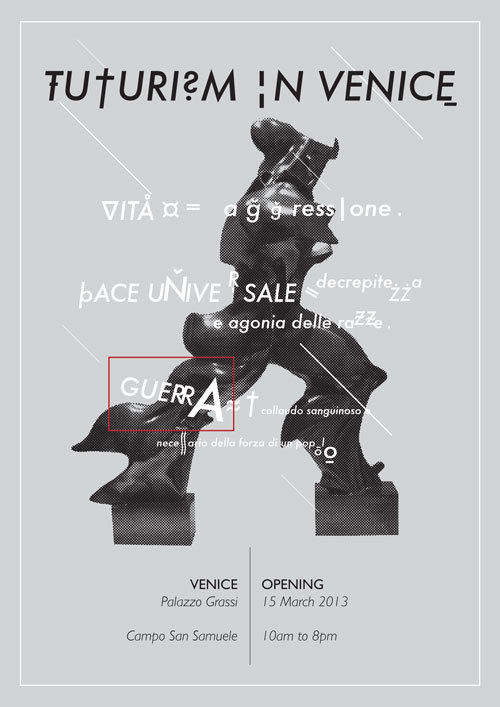
00:05 Publié dans art, Evénement | Lien permanent | Commentaires (0) | Tags : venise, ityalie, futurisme, art, avant-gardes |  |
|  del.icio.us |
del.icio.us |  |
|  Digg |
Digg | ![]() Facebook
Facebook
mercredi, 05 mars 2014
Italian Futurism
00:05 Publié dans art, Evénement | Lien permanent | Commentaires (0) | Tags : italie, événement, futurisme, art, avant-gardes |  |
|  del.icio.us |
del.icio.us |  |
|  Digg |
Digg | ![]() Facebook
Facebook
mercredi, 12 février 2014
P'tit Père des peuples

18:23 Publié dans art | Lien permanent | Commentaires (0) | Tags : caricature |  |
|  del.icio.us |
del.icio.us |  |
|  Digg |
Digg | ![]() Facebook
Facebook
mercredi, 22 janvier 2014
Italian Futurism 1909-1944
Edited and with introduction by Vivien Greene. Text by Walter Adamson, Silvia Barisione, Gabriella Belli, Fabio Benzi, Günter Berghaus, Emily Braun, Marta Braun, Esther da Costa Meyer, Enrico Crispolti, Massimo Duranti, Flavio Fergonzi, Matteo Fochessati, Daniela Fonti, Simonetta Fraquelli, Emilio Gentile, Romy Golan, Vivien Greene, Marina Isgro, Giovanni Lista, Adrian Lyttelton, Lisa Panzera, Maria Antonella Pelizzari, Christine Poggi, Lucia Re, Michelangelo Sabatino, Claudia Salaris, Jeffrey T. Schnapp, Susan Thompson, Patrizia Veroli.
Published to accompany the exhibition Italian Futurism, 1909–1944: Reconstructing the Universe opening at the Solomon R. Guggenheim Museum in 2014, this catalogue considerably advances the scholarship and understanding of an influential yet little-known twentieth- century artistic movement. As part of the first comprehensive overview of Italian Futurism to be presented in the United States, this publication examines the historical sweep of Futurism from its inception with F.T. Marinetti’s manifesto in 1909 through the movement’s demise at the end of World War II. Presenting over 300 works created between 1909 and 1944, by artists, writers, designers and composers such as Giacomo Balla, Umberto Boccioni, Anton Giulio Bragaglia, Fortunato Depero, Gerardo Dottori, Marinetti, Ivo Pannaggi, Rosa Rosà, Luigi Russolo, Tato and many others, this publication encompasses not only painting and sculpture, but also architecture, design, ceramics, fashion, film, photography, advertising, free-form poetry, publications, music, theater and performance. A wealth of scholarly essays discuss Italian Futurism’s diverse themes and incarnations.
00:05 Publié dans art, Livre, Livre | Lien permanent | Commentaires (0) | Tags : art, italie, futurisme, avant-gardes |  |
|  del.icio.us |
del.icio.us |  |
|  Digg |
Digg | ![]() Facebook
Facebook
lundi, 11 novembre 2013
Art contemporain : les élites contre le peuple

Art contemporain : les élites contre le peuple
L’art contemporain revendique volontiers l’héritage des « maudits » et des scandales du passé. Et cependant, « artistes » et laudateurs d’aujourd’hui ne réalisent pas que leurs scandales ne combattent plus les tenants de l’ordre dominant, mais ne constituent en fait qu’un outil de plus de la domination bourgeoise. Par ce qu’il prétend dénoncer, l’« art » dit « dérangeant » participe de la domination libérale, capitaliste, oligarchique et ploutocratique, à la destruction du sens collectif au profit de sa privatisation, à cette démophobie qui a remplacé dans le cœur d’une certaine gauche la haine des puissants et des possédants. Cet « art » dit « dérangeant » est en parfaite harmonie avec ces derniers.
Épargnons-nous un discours qui, trop abstrait, serait rejeté par les concernés, les défenseurs de cette pitrerie libérale-libertaire nommée « art contemporain ». Prenons donc quelques exemples, quelques « scandales » ou actions représentatives de ces dix dernières années. En 2002, l’Espagnol Santiago Sierra fait creuser 3000 trous (3000 huecos, en castillan) à des ouvriers africains pour un salaire dérisoire afin de, nous apprend-on, dénoncer l’exploitation capitaliste, revendiquant une « inspiration contestataire axée sur la critique de la mondialisation, de l’exploitation de l’homme par l’homme, de l’inégalité des rapports Nord-Sud et de la corruption capitaliste. Il n’hésite pas à faire intervenir dans ses performances des sans-papiers, des prostituées, des drogués et à les rémunérer pour leur présence », apprend-on en effet, par exemple sur le site d’Arte TV [1]. Exploiter pour dénoncer l’exploitation : à ce titre, on pourrait bien aller jusqu’à voir un artiste supérieur en Lakshmi Mittal, par exemple.
En 2009, le costaricien Guillermo Habacuc Vargas (cf. site personnel) organise, pour l’inauguration d’une expo à Milan, un banquet préparé avec la sueur des immigrants (littéralement : la nourriture contenait la sueur collectée des immigrants qui l’avaient préparée). Deux ans plus tôt, il s’était fait connaître parce qu’il aurait laissé mourir un chien, cela constituant une « œuvre » (la réalité de l’évènement – le galeriste a annoncé par la suite que le chien avait en fait été libéré – s’est effacée derrière la rumeur mondiale, qui fit l’affaire de ce médiocre). Fin 2012, le Belge Jan Fabre provoque un violent scandale – qui lui vaut d’ailleurs des coups et menaces physiques – pour un lancer de chats dans l’hôtel de ville d’Anvers. Pourquoi cette « performance » ? Pour un hommage au cliché Dali Atomicus…
Tenons-nous en à ce court inventaire pour l’instant : d’autres exemples suivront.
Merde aux petites gens : les élites contre le peuple
Qui donc dérange l’art dit « dérangeant » ? Que cherche-t-il à déranger ? Sont-ce les oppresseurs qui sont visés ? Bien sûr que non. Les dominants (le système capitaliste et ses organisateurs, le marché de l’art, les institutions validatrices et promotrices de l’art, les bourgeois cons-sommateurs de ce non-art con-tant-pour-rien), habitués aux registres de la parodie, de la provocation, de l’outrance, se satisfont du renouvellement des pitreries et des gesticulations.
Ceux que visent les provocations de l’art contemporain, dans bien des cas, sont surtout les gens ordinaires, ceux que les merdias appellent les « anonymes » parce que leur donner un nom, un droit à s’exprimer, est hors de question pour ces fameux « démocrates » – entendre le mot davantage au sens du parti politique américain capitaliste et libéral, qu’au sens antique et étymologique. Ce sont bien les « non-initiés » aux prétendus arcanes de l’« art » contemporain qui sont visés, les personnes extérieures à cet incestueux milieu, à ces coquetteries conceptuelles de bourgeois et de larbins wannabe. Pourquoi « déranger » ces gens ordinaires ? Parce qu’ils seraient dangereux ? rétrogrades ? secrètement puissants ? Parce qu’ils porteraient en eux le-germe-de-la-Bête-immonde-qui-rappelle-les-heures-les-plus-sombres-blablabla ?
« Ceux que visent les provocations de l’art contemporain, dans bien des cas, sont surtout les gens ordinaires, ceux que les merdias appellent les « anonymes » parce que leur donner un nom, un droit à s’exprimer, est hors de question pour ces fameux « démocrates »
Rapporté à l’énorme puissance financière, médiatique et symbolique du milieu – bourgeois – de l’art contemporain et de ceux qui le défendent, c’est pourtant dérisoire. C’est aussi piteux et veule que l’attitude des « éditocrates », cette bavarde racaille de naintellectuels médiatiques, à l’endroit des dominés et des « anonymes » (fermeté, mépris ou indifférence) [2]… mais toujours serviles devant le Capital et la ploutocratie libérale. Car n’est-il pas connu que les classes laborieuses sont des classes dangereuses, réactionnaires et mal éduquées ? Et que, à l’inverse, les grands patrons, les décisionnaires économiques et la jet-set politique sont dans le camp du Bien et du Progrès, celui qui se réunit en club de gens bien éduqués, au Siècle et qui toujours dira non à la Bête-immonde-et-aux-heures-les-plus-sombres ? D’ailleurs, les ploutocrates bien éduqués tels que Pinault ou Cartier, ne sont-ils pas de gentils progressistes amoureux de l’art et de la culture, comme l’atteste leur fondation ?
À la vérité, il y a que les gens ordinaires, les classes populaires, les campagnards, les banlieusards, mais encore les personnes de conviction (religieuse, politique, patriotique, culturelle…) ne méritent pas le respect – ni pour les policaillons arrivistes, ni pour les fonctionnaires validateurs de l’ââârt d’État, ni pour les pirates de la ploutocratie mondialisée… ni pour les « artistes » dits « dérangeants », communiant dans le mépris du peuple avec les maîtres du monde.
C’est pourquoi, est légitime et logique, d’un point de vue démophobique, un commando de femmes déguisées en Blanche-Neige et armées de – fausses – kalach qui s’en va donner une série de « performances » dans des villages de la Vienne… Quoi de plus logique en effet, au nom de l’ââârt démophobique, que de faire atterrir en hélicoptère (il ne serait pas inintéressant de savoir qui a financé cette pitrerie forcément coûteuse) des femmes déguisées en Blanche-Neige et armées et de les laisser défiler entre les étals d’un marché provincial ? Qu’importe si ça colle la pétoche à ces gueux [3] ; oui, qu’importe si le « sale peuple » ne voit que la kalachnikov et les déguisements de Blanche-Neige… Qu’importe s’il ne comprend pas l’ââârt de Catherine Baÿ et que pour elle « ce qui est important, c’est de créer des occasions de communiquer, de parler »[4], car le peuple n’est qu’un ramassis d’indécrottables arriérés – au fond, Patrick Le Lay avait sans doute raison de parler du « temps de cerveau humain disponible » que l’on vend à Coca-Cola, car il n’y a rien d’autre à tirer de cette chair à consommation que sont « les gens »… Heureusement pour son ââârt, Catherine Baÿ (cf. vidéo en tête de l’article), soutenue par les ronds-de-cuir validant l’art officiel d’État, aura par ailleurs la chance de faire l’intéressante au sein de l’institution beaubourgeoise… et de trouver ainsi un public d’esprits éclairés à la hauteur de son ââârt, qu’on appelle les élites, c’est-à-dire plus exactement ce que Christopher Lasch nommait « les nouvelles élites du capitalisme avancé ».
Dans un registre proche, citons un passage relatif à un certain Joseph Van Lieshout, qui rappelle que tout ce néant n’est au fond pas si « dérangeant » pour le système et qu’il ne vaut au fond guère mieux que des jeux de grands gamins inconséquents, indifférents au monde extérieur : « Lorsque Van Lieshout, à Rabastens, dans le Tarn, sillonne avec ses petites copines les rues de la bourgade à bord d’une Mercedes surmontée d’une mitrailleuse, installe un « baisodrome » sur la place du marché, entre vendeurs de coupons de tissu et de boudin noir et mime avec des gestes stéréotypés des poses de beuveries, il défraye à bon compte le landerneau. Mais en quoi cela gêne-t-il le système ? Au contraire, le spectaculaire, le burlesque, l’alimentent » [5].
Ce prétendu « art », au fond, n’a aucune vertu positive : il n’éclaire ni ne grandit l’individu ; il ne l’exhausse pas, il ne lui enseigne rien, il ne lui montre nulle part ce qu’il peut avoir de meilleur ou de grand – ni d’ailleurs de pitoyable – parce que, au fond, il ne croit en rien et n’a rien à enseigner, aucune valeur civilisante. Il refuse d’élaborer des repères symboliques, de défendre une vision, qui peuvent donner à une société et aux individus qui la composent de la dignité. Pour l’essentiel il dégrade l’individu, ajoute de l’incompréhension et de l’absurde à un monde absurde et opaque, à des existences morcelées, à une société en éclats conforme au projet libéral parcellitariste et au fameux mot de Margaret Thatcher selon lequel « il n’existe rien de tel que la « société » » (lire en anglais la citation intégrale), mais seulement des individus.
Ce prétendu « art » ne fait que célébrer le règne de l’arbitraire individuel, où le symbole d’un seul — exigeant qu’on en passe par sa tête ou l’intromission des experts théoriciens ou « critiques », ces néo-oracles chargés de déchiffrer ce qui n’a guère de sens et qui occupent dans le champ artistique une place comparable à celle des « experts » toujours néolibéraux de l’économie qui par leur amour de la complexité sont les grands confiscateurs de la démocratie, grands empêcheurs d’appréhension par la collectivité de sa destinée – vaut mieux que l’effort d’un langage commun. Tandis que l’art fut à travers l’histoire en majorité la production de formes, de signes, de symboles donnant leur cohérence à une culture, donnant à l’individu et au Je, le cadre de sa liberté parce qu’intégrée à la collectivité et au Nous, cet « art » affirme haut et fort le règne sadien de la pulsion égoïste d’êtres avant tout corporels, où les corps et la chair mêmes semblent réduits à n’être qu’un matériau indifférencié des autres, et où le souci d’autrui s’efface derrière un mépris tantôt diffus et tantôt éclatant de l’être humain.
Détruire les tabous, détruire la civilisation
« Car que recouvrent les appels répétés à transgresser, à dénoncer et détruire les tabous ? Une ambition sadienne : un retour à l’état de nature, la destruction des principes civilisants, la préférence à la pulsion égoïste plutôt qu’aux normes sociales, une conception au fond arriérée, pré-civilisationnelle de la liberté »
Car que recouvrent les appels répétés à transgresser, à dénoncer et détruire les tabous ? Une ambition sadienne : un retour à l’état de nature, la destruction des principes civilisants, la préférence à la pulsion égoïste plutôt qu’aux normes sociales, une conception au fond arriérée, pré-civilisationnelle de la liberté. Sur cette liberté-là, il y a lieu de s’interroger. Sigmund Freud traitait déjà en 1929, dans le chapitre III de Malaise dans la civilisation : « Cette tendance à l’agression, que nous pouvons déceler en nous-mêmes et dont nous supposons à bon droit l’existence chez autrui, constitue le facteur principal de perturbation dans nos rapports avec notre prochain ; c’est elle qui impose à la civilisation tant d’efforts. Par suite de cette hostilité primaire qui dresse les hommes les uns contre les autres, la société civilisée est constamment menacée de ruine. L’intérêt du travail solidaire ne suffirait pas à la maintenir : les passions instinctives sont plus fortes que les intérêts rationnels. La civilisation doit tout mettre en œuvre pour limiter l’agressivité humaine et pour en réduire les manifestations à l’aide de réactions psychiques d’ordre éthique (…). Si la civilisation impose d’aussi lourds sacrifices, non seulement à la sexualité mais encore à l’agressivité, nous comprenons mieux qu’il soit si difficile à l’homme d’y trouver son bonheur. En ce sens, l’homme primitif avait en fait la part belle puisqu’il ne connaissait aucune restriction à ses instincts. En revanche, sa certitude de jouir longtemps d’un tel bonheur était très minime. L’homme civilisé a fait l’échange d’une part de bonheur possible contre une part de sécurité ».
Merde aux tabous : Il est interdit d’interdire ! Et c’est bien ce à quoi s’attelle ce soi-disant « art contemporain », selon une logique libérale-libertaire et progressiste : chacun fait ce qu’il veut et sans se soumettre à des critères communs, car il faut aller vers un homme meilleur, débarrassé de ses pudeurs, ces archaïsmes. Dès lors, l’art peut consister en – littéralement – une série de branlettes (performance « Seedbed », de Vito Acconci, 1972), en des vomissements sur toile accompagnés d’un duo chantant (performance de Millie Brown, en 2011), en l’utilisation de : son sang (le boudin que fait avec son propre sang Michel Journiac, les orgies de sang de porc des Actionnistes viennois, la performance « Barbed Hoola » à l’alibi politique de Sigalit Landau ; citons encore Gina Pane, Marina Abramovic… ou, plus récemment, les popstars junkies Amy Winehouse et Peter Doherty) ; sa merde (le fondateur Piero Manzoni, mais aussi Jacques Lizène, Pierrick Sorin, David Nebreda…) ; les tourments de son intimité (Sophie Calle, Jonathan Meese, Louise Bourgeois et autres charlatans des « mythologies personnelles ») ; son arbitraire (ne citons que la ridiculissime Audrey Cottin) ; ou du vide, littéralement : Exposition des vides, à Beaubourg – sic – mais ne riez pas, philistins ! N’avez-vous donc pas compris qu’il est ici question d’ « interrogation de l’espace » ? Êtes-vous donc si incapables d’« [expérimenter] (…) un vide où advient la conscience de son propre corps dans un espace qui n’est pas neutre » ?
« Les provocations du XIXe siècle voulaient émanciper ; celle d’aujourd’hui veulent humilier, ringardiser, taire, tourner en dérision toute valeur, détruire les cadres et repères civilisants, ajouter un rire imbécile à l’universelle imbécillité de la Société du Spectacle et de la postmodernité. »
Pour éviter d’étirer à l’infini cet article, renvoyons enfin à quelques « artistes » dont la démarche consiste à sauter par-delà le tabou, au fondement même de la civilisation, du respect du cadavre : Teresa Margolles et le groupe SEMEFO (Mexique), le groupe Cadavre (Chine), dont les « œuvres » sont notamment une tête de fœtus humain sur un corps de mouette ou la « performance » Eating People de Zhu Yu consistant à manger un fœtus humain. Mentionnons encore le grand photographe américain Joel Peter Witkin, dont les mises en scènes macabres et hautement esthétiques ont pour matériau des morceaux de cadavres. Sur cette thématique, difficile de ne pas rappeler les cadavres plastinés de Günther von Hagens (1/3 Victor Frankenstein, 1/3 Josef Mengele, 1/3 Honoré Fragonard), succès massif partout dans le monde, fut interrompue à Paris en 2009, puis cette année à Bruxelles ; entre autres abjections dont il s’est rendu maître, signalons encore son « supermarché de la mort ». Mentionnons encore ce symptomatique article relatant l’exposition « Tous cannibales ! » à la Maison Rouge en 2011, dont l’auteur invitant à « déculpabiliser le cannibale qui sommeille en nous »… « Le tabou, c’est tabou, nous en viendrons tous à bout », pourraient entonner les « artistes » cons, tant, pour rien.
Serait donc risible et condamnable, fatalement « arriéré » et « réactionnaire » qui s’oppose à cette vision libérale-progressiste selon laquelle tout principe, tout tabou, toute limite, est un mur à abattre, non un cadre et un ensemble de repères, certes discutables, mais surtout structurants. L’art contemporain constitue donc bien souvent une attaque massive contre les principes de pudeur et de cette « décence ordinaire » chère à George Orwell. Les provocations du XIXe siècle voulaient émanciper ; celles d’aujourd’hui veulent humilier, ringardiser, taire, tourner en dérision toute valeur, détruire les cadres et repères civilisants, ajouter un rire imbécile à l’universelle imbécillité de la Société du Spectacle et de la postmodernité. Pure cochonnerie de cette ère où une expression si courante consiste à dire que « de toute façon, tout est relatif ».
Toutes ces manifestations « provocantes », tous ces artistes « dérangeants » visant à se « défaire des tabous »[6], sont radicalement semblables à tout ce mépris qui n’en finit plus de déferler dans la bouche des élites démophobes en sécession contre le peuple : « propos de PMU », « populistes ! », etc. Car c’est une éthique censitaire qu’il y a là derrière. Et toutes les poses vaines des « rebellocrates » n’y font rien : le capitalisme n’est pas menacé par ces âneries ; il est, au contraire, conforté dans sa dynamique de destruction des limites morales, repères symboliques, frontières et enracinements, tout cela qui permet à chacun d’avoir une dignité en s’inscrivant dans une histoire, des particularismes culturels, des symboles collectifs, de s’appuyer pour se construire en tant qu’individu sur des repères identitaires qui seuls permettent de s’ouvrir sur le monde – et non de se penser comme une monade.
L’art contemporain contre la démocratie
« Cet art n’est ni politique ni démocratique : il se fiche de la polis et méprise le démos ; il est foncièrement anti-culturel et anti-civilisationnel puisque les deux exigent que le Nous prime sur le Je, que le Nous soit la condition – limitée, encadrée, donc civilisée – de la liberté du Je»
Cet « art » dit « dérangeant » n’élève pas : il dégrade. Il valorise l’idée d’individus comme monades, comme îlots, comme isolats. Tout ce dont, précisément, le système marchand se repaît : plus l’être est isolé, moins il a de repères et plus il en cherche. Et ceux, inaccessibles, que lui propose le système des représentations de la Société du Spectacle, ne génèrent que de la frustration. La solitude et la honte de soi sont les conditions mêmes du consumérisme de masse. Et contre cela, malgré des dénonciations çà et là dans le monde de l’art contemporain, rien n’est énoncé, ou si peu. La dynamique générale est précisément celle de la privatisation du sens, du repli sur son nombril et sa « mythologie personnelle ».
Il n’est donc guère surprenant que, rejetant la culture, la civilisation, les critères, les frontières, l’art contemporain soit si souvent égocentrique, pleurnichard, autistique, de Sophie Calle à David Nebreda, en passant par Louise Bourgeois, Jonathan Meese. Des démarches toutes en phase avec l’individualisme de masse du temps, qu’on aurait tort de qualifier de narcissisme, puisque Narcisse était amoureux de son image, tandis que bien des artistes ont d’eux-mêmes une image dévalorisante d’éternels adolescents incapables de devenir adultes en prenant en compte pleinement l’existence d’autrui, la société, donc les symboles et les limites qui bornent l’affirmation d’une singularité. Autant de démarches qui rappellent les propos de Tocqueville selon qui la pulsion individualiste « fait oublier à chaque homme ses aïeux, mais lui cache ses descendants et le sépare de ses contemporains ; elle le ramène sans cesse vers lui seul et menace de le renfermer enfin tout entier dans la solitude de son propre cœur » [7].
L’art contemporain, dans son versant « provocant », ne menace ni ne dénonce le consumérisme, l’addiction aux nouvelles technologies, le culte du choc, du sexe et du bling-bling, la haine de la Beauté et des symboles. Même quand il prétend le faire, ce n’est que pour reproduire à l’identique — sans sublimation, donc — ce qu’il dénonce. Ce faisant, il participe de la même dynamique de « culture » globalitaire. Par son caractère abscons, voire autistique, parce que rejetant les symboles, codes et langages permettant un sens commun, il privatise le sens, rend illisible ce qu’il énonce (puisqu’il faut passer par sa tête, par tel texte abscons ou tel « médiateur » récitant le catéchisme de l’orthodoxie de l’art), si bien qu’il est impossible à cet art de nourrir l’esprit, d’aider à se percevoir, à se comprendre soi dans son rapport au monde, à autrui, aux limites, donc à la société, à la communauté, à la civilisation. Cet art n’est ni politique ni démocratique : il se fiche de la polis et méprise le démos ; il est foncièrement anti-culturel et anti-civilisationnel puisque les deux exigent que le Nous prime sur le Je, que le Nous soit la condition – limitée, encadrée, donc civilisée – de la liberté du Je.
Et cet art méprise d’autant plus la polis et le démos qu’il n’est, en fait, de nulle part. Que, tout comme McDonald’s ou H&M, il peut indistinctement s’exposer à Tokyo, à Rome, à New York ou à Johannesburg, car il est sans ancrage, sans passé, sans langage. Apatride comme les élites bourgeoises et les néoféodales oligarchies ploutocratiques, qui partout détruisent la démocratie au profit du marché et de l’État répressif.
Cet « art »-là n’a rien de politique, donc, et encore moins de révolutionnaire – sauf à comprendre le mot au sens le plus strict d’un retour aux origines, d’une grande boucle consistant à revenir à la sauvagerie pré-civilisationnelle, cette bonne vieille aspiration sadienne. La sécession qu’il propose, n’est pas celle d’avec les élites capitalistes et antidémocratiques, mais d’avec le peuple, d’avec l’histoire, d’avec la tradition, d’avec les tabous, les normes, les cadres – et pourquoi pas les lois elles-mêmes ? Loin d’être révolutionnaire au sens de rupture avec l’ordre établi, il y est en fait totalement intégré, et ses « provocations » et « dérangements » sans cesse vantés ne sont que les formes perpétuellement régénérées de la culture de masse dont parlait Christopher Lasch, nécessaires au renouvellement du capitalisme libéral-libertaire, en tant que culture de l’illimitation et d’indifférence à l’Autre.
Or, sans morale, sans limites à la liberté de chacun, il n’y a pas de civilisation possible. Tous les chefs-d’œuvre du passé s’inscrivaient dans les limites morales et politiques, les codes artistiques, qui étaient les conditions mêmes de l’existence d’une civilisation. Même lorsque le scandale existait, il restait circonscrit au cadre de l’art, c’est-à-dire à un jugement à la fois éthique et esthétique, les deux étant indissociablement reliés – il suffit de se souvenir que pour Diderot, l’art avait une vocation civique, donc une responsabilité (« Obligation faite à une personne de répondre de ses actes du fait du rôle, des charges qu’elle doit assumer et d’en supporter toutes les conséquences », CNRTL). Que des critiques jugeassent que Van Gogh n’était pas un artiste ou que les productions des Expressionnistes traduisissent une dégénérescence de l’esprit selon la théorie de Max Nordau, cela signalait précisément l’existence d’un abord d’où juger, donc des critères moraux, sociaux, esthétiques – lesquels ne sont pour autant pas figés à jamais (l’art du temps de Robert Campin n’est pas celui du temps de Jacques-Louis David, et cependant dans les deux cas des critères existent, qui ne relèvent pas de l’arbitraire d’une caste confisquant le mot « art »).
Si l’on examine de près l’idéologie qu’est « l’art contemporain », il en ressort que ce fatras d’imbécillités libérales et progressistes, n’est au fond qu’un vaste mouvement contre la culture et, partant, contre la civilisation. Proclamant le règne de la pulsion et de l’arbitraire individuels, il rejette de fait le sens commun et la possibilité de faire communauté. À ce titre, l’art contemporain n’est que l’alibi « culturel » et le bras armé du capitalisme néolibéral et des valeurs libérales-libertaires où communient les élites de droite et celles qui se pensent encore de gauche cependant qu’elles ont du peuple le plus profond mépris.
Notes :
[1] Sur le site du centre d’art andalou Fundación NMAC, on peut lire cet explicatif : « Ses œuvres reflètent son inconformité face au système social dans lequel nous vivons et mettent en évidence les différences sociales et raciales. Le concept principal sur lequel se base sa trajectoire artistique est relié avec le travail, surtout celui des immigrants et des marginaux de la société, avec l’absence d’opportunités et la soumission à l’activité du travail ayant pour fin le salaire et l’entretien du système capitaliste. Selon ces prémices, dans quelques-uns de ses travaux, l’artiste a engagé contractuellement des travailleurs pour réaliser des actions inutiles durant une journée de travail ». (« Sus obras reflejan su inconformidad ante el sistema social en el que vivimos y ponen en evidencia las diferencias sociales y raciales. El concepto principal en el que se basa su trayectoria artística está relacionado con el trabajo, sobre todo con el de los inmigrantes y los marginados sociales, con la falta de oportunidades y la sumisión a la actividad laboral con el fin de recibir un salario y permitir el funcionamiento del sistema capitalista. Siguiendo esta premisa, en algunos de sus trabajos, el artista ha contratado a trabajadores para realizar acciones inútiles durante una jornada laboral »).
[2] Qu’on se souvienne de la leçon de civisme que donne du haut de son surplomb bourgeois ce nabot de Pujudas à Monsieur Xavier Mathieu, délégué syndical CGT de Continental ; qu’on se souvienne l’indifférence et le mépris de l’éditocratie à l’encontre de Mademoiselle Nafissatou Diallo, lorsque le bien aimé ploutocrate-acronyme DSK fut accusé de viol ; et plus généralement, idem pour les banlieusards, les immigrés, le monde ouvrier, la paysannerie, les précaires, etc.
[3] Le Parisien rapporte ces propos d’une femme relayés par le journal local Centre Presse : « J’ai cru qu’ils allaient faire un hold-up ! ».
[4] Ne faisons pas preuve de philistinisme facile : la vraie intention de Catherine Baÿ, c’est de générer des rumeurs, afin que les gens se parlent. Cette conception d’un art consistant en somme à faire quelque chose d’absurde pour faire se parler les gens, est aussi celle du Belge Francis Alÿs, lorsqu’il pousse un grand cube de glace dans les rues de Mexico (Paradox of Praxis (Sometimes Making Something Leads to Nothing), 1997) : « La dispersion laisse voir un paradoxe, comme le titre le suggère. Si l’objet disparaît (le bloc de glace), son effacement produit en retour un déplacement vers une autre sorte de mobilité où c’est le geste qui survit par le récit de ceux et celles qui raconteront leur version ou plutôt leur portion de l’histoire de cette étrange glace. Raconter implique de disséminer dans l’espace et dans le temps » (Marie Fraser, à lire ici)…
[5] Alain Georges Leduc, Art morbide / Morbid Art, de la présence de signes et de formes fascistes, racistes, sexistes et eugénistes dans l’art contemporain, éd. Delga, 2007, p. 45
[6] Citons un seul récent exemple, symptomatique, à savoir le texte de présentation du festival parisien Zone d’occupation artistique (ZOA), organisé par Sabrina Weldman et qui s’est tenu en octobre 2012 à La Loge (Paris) : « Rebelle, hors-cadre, ZOA, Zone d’occupation Artistique, est une nouvelle manifestation qui souhaite mettre en lumière la jeune génération de chorégraphes et de performeurs. En un refus de se plier aux convenances et aux tabous, ce festival entend donner une visibilité à des artistes émergents : inscrits dans notre temps, ils lui font écho par des propositions brassant l’identité, la relation à l’autre, le collectif, la norme, le politique, l’érotisme, la fantasmagorie, l’inconscient,… ».
[7] De la démocratie en Amérique (Garnier-Flammarion, 1981, vol. 2, p. 127).
- Source : Ragemag
00:05 Publié dans art | Lien permanent | Commentaires (0) | Tags : art, art contemporain, mystification |  |
|  del.icio.us |
del.icio.us |  |
|  Digg |
Digg | ![]() Facebook
Facebook
jeudi, 17 octobre 2013
Die Geburt der Moderne
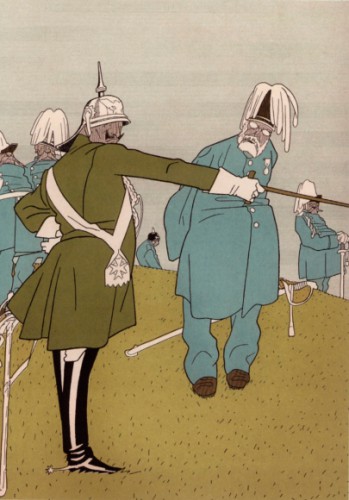
Die Geburt der Moderne
von Benjamin Jahn Zschocke
Ex: http://www.blauenarzisse.de
 Der Nationalsozialismus ist der absolute Fixpunkt der deutschen Geschichte – wirklich alles ballt sich zu ihm hin. Alle zeitlich daran angrenzenden Epochen verschwinden in seinem Schatten.
Der Nationalsozialismus ist der absolute Fixpunkt der deutschen Geschichte – wirklich alles ballt sich zu ihm hin. Alle zeitlich daran angrenzenden Epochen verschwinden in seinem Schatten.
Der in Chemnitz lehrende Professor für Europäische Geschichte des 19. und 20. Jahrhunderts Frank-Lothar Kroll ist dafür bekannt, eine mittelbar an diese Zeit angrenzende Epoche, nämlich das Deutsche Kaiserreich von 1871 bis 1918, dankenswerter Weise aus diesem Schatten hervorzuholen. Unter Zuhilfenahme aller verfügbaren historischen Quellen betrachtet er diese Epoche so, wie sie war und nicht, wie sie laut der verengten Sichtweise eines „deutschen Sonderweges“ – bei einem gleichzeitig angenommenen „westeuropäischen Normalweg“ – gewesen sein soll.
Ein umfassendes Update der Quellenlage
Krolls aktuellstes Werk Geburt der Moderne. Politik, Gesellschaft und Kultur vor dem Ersten Weltkrieg unternimmt auf reichlich 200 Seiten den Versuch, einen Gesamtüberblick über die gesellschaftlichen Entwicklungslinien zwischen 1900 und 1914 zu geben. Da dies in solcher Kürze fast unmöglich scheint, verzichtet Kroll auf alle narrativen Elemente und gibt dem Leser in höchster Komprimierung sozusagen ein Update der aktuellen Quellenlage, in deren Ergebnis die Annahme des besagten „deutschen Sonderweges“ ebenso definitiv zu den Akten gelegt werden muß, wie das „persönliche Regiment“ unseres letzten Kaisers Wilhelm II.
Die seit gut fünfzig Jahren praktizierte „germanozentrische“ Herangehensweise gelangt bei Kroll ebenfalls auf die Deponie. Vielmehr gehört der historische Blickwinkel nach seinem Verständnis auf eine europäische Dimension geweitet, was allein angesichts der verästelten außenpolitischen Bündnisse dieser Epoche gar nicht anders möglich ist.
Doch Krolls Schwerpunkt liegt in diesem Buch definitiv nicht auf dem Ersten Weltkrieg: ungleich mehr interessiert ihn der kulturelle und soziale Entwicklungsstand eines Landes, das zur damaligen Zeit das fortschrittlichste der Welt war. Krolls große Stärke ist es, nicht nach Belieben zu werten, sondern nüchtern Fakten um Fakten vorzutragen und damit großkalibrig gegen die an deutschen Gymnasien, Universitäten und in den Medien herrschende Guido Knopp-Mentalität vorzugehen.
Kultureller Vorreiter des Kontinents
Besonders der kulturelle Schwerpunkt reizt an Krolls Buch. Die titelgebende These, nach der die Moderne bereits zwischen 1900 – 1914 unter Wilhelm II. ihren Anfang nahm sowie erste Schwerpunkte herauskristallisierte – und damit nicht erst in den gepriesenen (dekadenten und auf Kredit finanzierten) so genannten Goldenen Zwanzigern – macht die Lektüre besonders empfehlenswert. Walther Rathenau schrieb schon 1919 in seinem Text Der Kaiser: „Für Kunst lag [beim Kaiser, Anm. BJZ] eine entschiedene formale Begabung zugrunde, die in rätselhafter Weise über die kunstfremde Umgebung emporhob […]. So ergab sich von selbst der Anspruch des künstlerischen Oberkommandos.“
Unter anderem am Beispiel der Kulturreform aber auch der Jugendbewegung arbeitet Kroll heraus, welche in Europa zur damaligen Zeit einmalige Fülle an verschiedenartigsten Kulturinstitutionen entstand und sich in aller Ruhe, teils sogar mit erheblichen Finanzspritzen, entwickeln konnte. Am bekanntesten sind auf dem Gebiet der Kunst wohl die Strömungen des Jugendstils, des Expressionismus und des Impressionismus, die zwischen 1900 – 1914 ihren Anfang nahmen. Besonders mit Blick auf Letzteren lohnt ebenso die Lektüre des bereits 1989 bei Königshausen & Neumann erschienenen Werkes von Josef Kern Impressionismus im Wilhelminischen Deutschland.
Weimars Probleme im Voraus erkannt – und behoben
Der oben mit „Guido Knopp-Mentalität“ zusammengefaßten Erscheinung heutiger Geschichtsschreibung (eigentlich politischer Bildung), tritt Kroll mit aller Entschiedenheit entgegen: Erhellend sind zum Beispiel seine Erkenntnisse auf dem Gebiet der Presse– und Parteienlandschaft. Er spricht hier von einem „beispiellosen Pluralismus“. Außerdem wird die vielzitierte, himmelschreiende Armut der späten Phase der Industrialisierung (auf die im gymnasialen Geschichtsunterricht „zufällig“ eine monatewährende Behandlung der deutschen Arbeiterbewegung folgt) als Ammenmärchen enttarnt: „Wirkliche Massenarmut, die zur Verelendung trieb, gab es im wilhelminischen Deutschland – anders als im viktorianischen und edwardianischen England – nicht, wenngleich, die Mehrheit der Arbeiterschaft von sehr bescheidenen Einkommen zehrte.“
Am schwerwiegendsten sind, mit Blick auf den anfangs benannten Schatten einer gewissen Epoche wohl Krolls Feststellungen zum angeblich durch und durch judenfeindlichen Deutschland unter Wilhelm II.: „Die unmissverständliche Zurückweisung solcher Zumutungen seitens des Kaisers und der Reichsregierung verdeutlichte einmal mehr, dass im ‚ausgleichenden Klima des wilhelminischen Obrigkeitsstaates‘ dem politischen Einfluss radikalisierter Massen und Massenbewegungen, anders als in den späten Jahren der Weimarer Republik, enge Grenzen gesetzt waren.“
An anderer Stelle wird Kroll noch deutlicher: „Dass sich die Mobilisierung antisemitischer Ressentiments in Deutschland – und nicht etwa in Frankreich, wo sie vor und nach der Jahrhundertwende weitaus stärker verbreitet waren – Jahrzehnte später zu einer parteipolitischen Massenformation verdichten und schließlich in die Katastrophe des ‚Dritten Reiches‘ einmünden sollte, lag, bei aller partiell vorhandenen gesellschaftlichen Diskriminierung der rechtlich gleichgestellten Juden im Kaiserreich, nicht an strukturellen Defiziten oder Defekten des vermeintlichen wilhelminischen Obrigkeitsstaates. Eigentliche Ursache waren vielmehr die fatalen Konsequenzen der militärischen und politischen Niederlage Deutschlands im Ersten Weltkrieg.“
Hörenswerte Audio-Rezension bei Deutschlandradio Kultur.
Frank-Lothar Kroll: Geburt der Moderne. Politik, Gesellschaft und Kultur vor dem Ersten Weltkrieg. Band 1 der Reihe Deutsche Geschichte im 20. Jahrhundert. 224 Seiten, Be.Bra Verlag 2013. 19,90 Euro.
Josef Kern: Impressionismus im Wilhelminischen Deutschland. Studien zur Kunst– und Kulturgeschichte des Kaiserreichs. 476 Seiten, Königshausen & Neumann Verlag 1989. 50,00 Euro.
00:05 Publié dans art, Livre, Livre, Révolution conservatrice | Lien permanent | Commentaires (0) | Tags : modernisme, modernité, allemagne, livre, histoire, art |  |
|  del.icio.us |
del.icio.us |  |
|  Digg |
Digg | ![]() Facebook
Facebook
jeudi, 05 septembre 2013
Enki Bilal - Exposition
00:05 Publié dans art, Bandes dessinées, Evénement | Lien permanent | Commentaires (0) | Tags : événement, exposition, paris, art, bande dessinée, bd, 9ème art, enki bilal |  |
|  del.icio.us |
del.icio.us |  |
|  Digg |
Digg | ![]() Facebook
Facebook
dimanche, 18 août 2013
Porträt A. Paul Weber
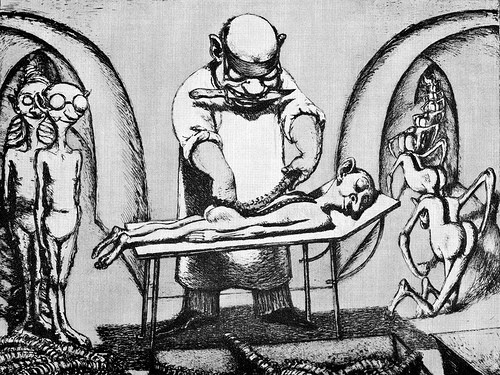
Porträt A. Paul Weber
von Christoph George
Ex: http://www.blauenarzisse.de
Die Graphiken A. Paul Webers (1893−1980) gehören zu den bekanntesten künstlerischen Äußerungen der deutschen Rechten. An Aktualität haben sie bis heute nichts eingebüßt.
Der aus dem thüringischen Arnstadt stammende Heinrich Andreas Paul Weber, so sein bürgerlicher Name, schuf während seiner Schaffenszeit über 5000 Graphiken. Von 1908 bis 1914 war er Mitglied im Jung-Wandervogel. Seine hier geweckte Liebe zu Nation und Natur spiegelten sich in vielen seiner späteren Werke. Erfahrungen konnte er bereits als Gebrauchsgraphiker sammeln, bis er 1916 erste Karikaturen und Zeichnungen für die Zeitschrift der 10. Armee entwarf.
Weber beschäftigte sich mit den unterschiedlichsten Themen. Zeichnungen wie Der Denunziant, Wir sind überm Berg! oder Das Gerücht, haben über die Jahrzehnte längst Kultstatus erreicht. Sie dürften mittlerweile bekannter sein als ihr Schöpfer. Die übrigen Zeichnungen werden gern vergessen ‒ lohnen sich jedoch unzweifelhaft für eine nähere Betrachtung.
Die NS-Bewegung als reaktionäre Nebelkerze
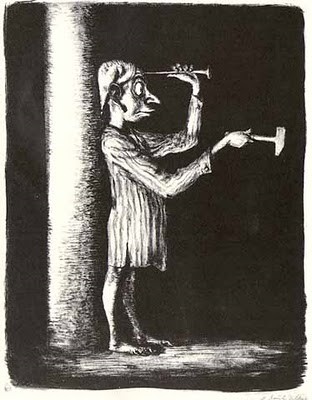 Zusammen mit Ernst Niekisch und dessen Widerstands-Verlag brachte Weber 1932 die Schrift Hitler – Ein deutsches Verhängnis heraus, der er fünf Federzeichnungen beifügte. Eine der erschütterndsten Darstellungen trägt den Titel Der Sumpf. Unter düsterem Himmel ist ein schier endlos erscheinendes Feld zu sehen, welches gespickt mit zerfetzten Fahnen und einer Standarte ist. Aus Gräbern gestreckt, bieten sich unzählige Arme zum Hitlergruß dar. Obwohl hier vor allem das Versinken der NS-Bewegung im bürgerlichen Sumpf angeprangert werden sollte, schwingt im Bilde doch eine dunkle Vorahnung mit. Das lag auch in der Intention des Künstlers.
Zusammen mit Ernst Niekisch und dessen Widerstands-Verlag brachte Weber 1932 die Schrift Hitler – Ein deutsches Verhängnis heraus, der er fünf Federzeichnungen beifügte. Eine der erschütterndsten Darstellungen trägt den Titel Der Sumpf. Unter düsterem Himmel ist ein schier endlos erscheinendes Feld zu sehen, welches gespickt mit zerfetzten Fahnen und einer Standarte ist. Aus Gräbern gestreckt, bieten sich unzählige Arme zum Hitlergruß dar. Obwohl hier vor allem das Versinken der NS-Bewegung im bürgerlichen Sumpf angeprangert werden sollte, schwingt im Bilde doch eine dunkle Vorahnung mit. Das lag auch in der Intention des Künstlers.
Die Reihe dieser gegen Hitler gerichteten Bilder ist aus der nationalrevolutionären Richtung heraus zu verstehen, wie sie damals insbesondere Ernst Niekisch vertrat. Nach Niekischs Theorie mußte die drohende Hitlerherrschaft in einer erneuten totalen Niederlage Deutschlands gipfeln. Er sah in Hitler nur einen Vertreter der für ihn überholten wilhelminischen Epoche. Niekisch jedoch war der Ansicht, Deutschland bedürfe eines revolutionären Staatsmannes. Der uniformierte Kleinbürger in Gestalt Hitlers aber verzichte zugunsten eines bürgerlichen Lebensstils auf die Strenge der eigentlichen Herausforderung der Zeit. Unter dieser Prämisse bleibt auch das bekannteste Bild aus dieser Reihe, Deutsches Verhängnis, zu verstehen, welches später auch in Schulbüchern abgedruckt wurde.
Zeichnungen für die Kriegspropaganda
Nach der Inhaftierung Niekischs 1937 wegen angeblichen Hochverrats wurde auch Weber für einige Monate verhaftet. Gegen Kaution kam er nach circa einem halben Jahr wieder frei. Trotz grundsätzlich distanzierter Haltung zum NS-Regime und seinen Zeichnungen für den Widerstands-Verlag arbeitete Weber während des Zweiten Weltkrieges auch für die deutsche Kriegspropaganda. Nach eigenen Angaben hätte er jedoch nichts gezeichnet, womit er ohne Goebbels Auftrag nicht einverstanden gewesen wäre. Bemerkenswert bleiben aus dieser Periode vor allem die antibritischen Zeichnungen, insbesondere die Bilder Der Plumpudding und Westminster. Aus ihnen spricht eine deutsche Sicht auf den westlich-liberalen Kapitalismus und dessen vermeintliche Segnungen.
Selten jedoch schockieren Webers Bilder derart wie in Der Sumpf. Ein typisches Bild Webers ist geprägt durch weiche Formen, üppige Rundungen und irrwitzige Gestalten. Sie lassen in das Thema, und sei es noch so ernst, eine deutliche Spur Gelassenheit einfließen. Gerade das dargestellte Böse erscheint bei Weber aber nicht weniger bedrohlich als etwa bei dessen Künstlerkollegen Alfred Kubin, dessen Bilder zumeist auf den ersten Blick schon schockierend auf den Betrachter wirken.
Aber Weber erzeugt gerade dadurch, daß er den eigentlichen Schrecken auf eine tiefere Ebene in seinen Bildern verlagert, einen Sinn für eben jene Banalität menschlicher Unzulänglichkeiten. Der Schrecken vermittelt sich dem Betrachter nicht sofort, sondern erst durch die nähere Beschäftigung. Die Möglichkeit der Bewahrung menschlicher Größe bleibt so gewahrt, während Kubin vor allem ein Gefühl der Hilflosigkeit erzeugt.
Durch gegenständliche Kunst zu höheren Wahrheiten
Es gilt hier, was Martin Heidegger über das Kunstwerk am Beispiel des Schuh-Gemäldes van Goghs sagte. Durch deren Darstellung erfahren wir weniger, was es mit jenen konkret gemalten Schuhen auf sich hat. Vielmehr bekommen wir durch ihre Darstellung eine Idee der Schuhe an sich vermittelt: Sie werden durch das Kunstwerk aus der Zeit heraus genommen und verkünden so eine höhere Wahrheit. Das zeigt sich ebenso an Webers Lithographie Rückgrat raus!
Ein weiteres Bild Webers ziert das soeben neu erschienene Buch Manfred Kleine-Hartlages: Der Schlag ins Leere von 1951. Zu sehen ist darauf der deutsche Michel mit Schlafmütze und Nachthemd. An einem Baum stehend, einer Hinrichtungsszene gleich, scheint er Suizid zu begehen. Er hält sich einen Zimmermannsnagel an den Kopf und will mit dem Hammer darauf schlagen. Der apathische Blick erinnert dabei an einen Zustand der Trance, wie er im Zusammenhang mit einer absurden Tat unter Hypnose denkbar wäre.
Tod oder Kopfschmerz
Das Bild passt ohne Frage auch in unsere zeitlichen Umstände. Es erfüllt seine Aufgabe, indem es die erkannte Tendenz auf die Spitze treibt und künstlerisch wiedergibt. Die Situation aus dem Bild heraus zu Ende denkend, eröffnen sich dem Betrachter dabei zwei Konsequenzen des anstehenden Schlages: Bei der einen reicht die selbstdestruktive Kraft aus, um den Nagel bis in den Baumstamm hinein zu treiben. Andernfalls wacht Michel unter gehörigem Kopfschmerz durch den zu laschen Schlag auf. Nach überwundener Verwirrung findet er zurück zur Besinnung. Webers Zeichnungen bieten uns stets ein Stückchen Hoffnung vor der drohenden Katastrophe.

Buchempfehlung: Helmut Schumacher/Klaus J. Dorsch: A. Paul Weber – Leben und Werk in Texten und Bildern. Verlag E. S. Mittler & Sohn 2003. 352 Seiten. 356 s/w– und 17 Farbabbildungen. Antiquarisch ab 18 Euro erhältlich.
00:05 Publié dans art | Lien permanent | Commentaires (0) | Tags : a. paul weber, allemagne, art, satire, art satirique |  |
|  del.icio.us |
del.icio.us |  |
|  Digg |
Digg | ![]() Facebook
Facebook
vendredi, 21 juin 2013
In herinnering aan Marc. Eemans

In herinnering aan Marc. Eemans (16 juni 1907 - 28 juli 1998)
Marc. Eemans wordt geboren op 16 juni 1907 te Dendermonde. Hij is onder meer actief als dichter, schilder en kunsthistoricus.
Al op zeer jonge leeftijd vertrouwd geraakt met het Brusselse artistieke milieu, begint hij onder invloed van Victor Servranckx zich op 15-jarige leeftijd te wijden aan de abstracte schilderkunst. In deze periode volgt hij lessen bij de symbolistische schilders Constant Montald en Emile Fabry. Hij schrijft voor toonaangevende avantgarde-tijdschriften als Het Overzicht, De Driehoek en Sept-arts. Vanaf 1925 schildert Eemans niet langer abstract. Hij ondergaat sterk de invloed van André Breton's Manifeste du surréalisme dat in het voorafgaande jaar verschijnt. Eemans onderhoudt intensieve contacten met de Brusselse surrealistische kring en geldt ook hier als de jongste binnen het gezelschap. Aanvankelijk voelt hij zich aangetrokken tot het communisme en schrijft hij in 1926 samen met de bevriende dichter René Baert Le Manifeste de l'Humanisme. Eemans' bronnen zullen echter veeleer mystiek van aard zijn. Een vroeg aanwezige belangstelling voor het werk van o.a. de Engelse en Duitse romantici (Percy Bysshe Shelley, Novalis), William Blake, Maurice Maeterlinck en Comté de Lautréamont wijst hem in deze richting. In 1930 komt het tot een definitieve breuk met de Brusselse kring en vervolgt hij zijn eigen weg. Datzelfde jaar richt Eemans samen met Baert de uitgeverij Hermès op, dat Eemans' eerste dichtbundel Vergeten te worden publiceert. Het (Franstalige) tijdschrift Hermès verschijnt van 1933 tot 1939 en wijdt speciale afleveringen aan (o.a.) Jan Ruusbroec, de Middelnederlandse mystiek, Meester Eckhart en het Soefisme. Niet onbelangrijk zijn de door Henry Corbin gerealiseerde Franse vertalingen van Duitse existentialistische auteurs (Martin Heidegger, Karl Jaspers). In nabeschouwing zou het project volgens Eemans gelijkenissen vertonen met de esoterische kring Gruppo di Ur, in 1927 mede-opgericht door de Italiaanse filosoof Julius Evola.
 Eemans romantische en aristocratische gezindheid doen hem evolueren naar een eerder mythisch geïnspireerd nationaalsocialisme. “Eemans [zag] in het nazisme vooral een terugkeer tot de oertraditie, de wedergeboorte van een sacrale en magische wereld die ten onder was gegaan aan de technische, democratische maatschappij.” (1) Het in 1944 verschenen L'épreuve du feu: à la recherche d'une éthique van de hand van René Baert vormt een blauwdruk van deze visie.
Eemans romantische en aristocratische gezindheid doen hem evolueren naar een eerder mythisch geïnspireerd nationaalsocialisme. “Eemans [zag] in het nazisme vooral een terugkeer tot de oertraditie, de wedergeboorte van een sacrale en magische wereld die ten onder was gegaan aan de technische, democratische maatschappij.” (1) Het in 1944 verschenen L'épreuve du feu: à la recherche d'une éthique van de hand van René Baert vormt een blauwdruk van deze visie.
In reactie op de naoorlogse Belgische kunst, die dan voornamelijk abstract-georiënteerd is, sticht Eemans in 1958 samen met de Waals-Brusselse schilder Aubin Pasque Fantasmagie, het driemaandelijkse tijdschrift van het Centre International d'Actualité Fantastique et Magique. Ze vertegenwoordigt een fantastische schilderkunst (en literatuur) die navolging vindt in o.a. Frankrijk, Duitsland, Nederland, Tsjecho-Slowakije en Joegoslavië.
In de jaren 1970 komt Eemans in aanraking met het werk van Julius Evola, wiens traditioneel metafysische opvattingen hem diepgaand zullen beïnvloeden. Hij bezoekt Evoliaanse kringen in Italië en treedt in contact met Renato del Ponte, stichter van het Centro Studi Evoliani in Genua en redacteur van het tijdschrift Arthos. Er wordt overgegaan tot de vorming van een Brusselse studiekring (Studi Evoliani Bruxelles) die kortstondig nieuwsbrieven verzorgt, teksten en vertalingen uitgeeft, maar op weinig belangstelling kan rekenen.
Ter gelegenheid van Eemans' 65e verjaardag wordt door vrienden in 1982 een Marc. Eemans-stichting opgericht. Ongeacht haar functioneren was de doelstelling – het bestuderen van idealistische en symbolistische kunst en literatuur – ambitieus. Een archief van kunst, literatuur en muziek met betrekking tot diverse symbolen en mythen, niet slechts van België maar van Europa en elders in de wereld, zou worden ontsloten.
Nog tot in zijn laatste jaren geeft Eemans dissidente beschouwingen over zijn kunstenaarschap en het Belgische surrealisme.
Aanbevolen literatuur
Jespers, Henri-Floris (20-09-2009). Marc. Eemans en de 'gnostische' schilderkunst. (http://mededelingen.over-blog.com/article-36310697.html)
Tommissen, Piet (1972). Inleiding tot de idee Marc. Eemans. Brussel: Henry Fagne. (http://marceemans.wordpress.com/2012/08/15/p-tommissen-inleiding-tot-de-idee-marc-eemans)
Voor teksten van Marc. Eemans, zie http://marceemans.wordpress.com
Noten
(1) Henri-Floris Jespers, 'Marc. Eemans 90 jaar: een biecht', in: BRUtaal I (1997), nr. 1, p. 12.
00:04 Publié dans art, Belgicana | Lien permanent | Commentaires (0) | Tags : marc eemans, surréalisme, tradition, traditionalisme, belgicana, art, avant-gardes |  |
|  del.icio.us |
del.icio.us |  |
|  Digg |
Digg | ![]() Facebook
Facebook
mardi, 18 juin 2013
La spiritualità di Marinetti
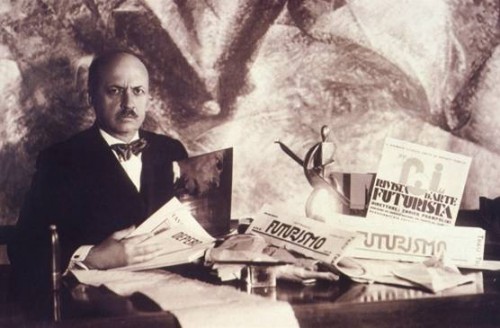
La spiritualità di Marinetti: fra anticlericalismo, spiritismo e cristianesimo
È noto come il Programma sansepolcrista del 1919 fosse fortemente anticlericale e presentasse addirittura un piano di “svaticanizzazione” dell’Italia mediante il sequestro di beni e l’abolizione dei privilegi ecclesiastici. All’adunata di piazza San Sepolcro del 23 marzo 1919 a Milano partecipa anche Filippo Tommaso Marinetti in qualità di leader del Partito Politico Futurista.
L’anticlericalismo di Marinetti ben si sposa con quello del movimento fascista, anzi è ancor più radicale di quest’ultimo, come si evince dal manifesto “Contro il Papato e la mentalità cattolica, serbatoi di ogni passatismo”, sempre del 1919, in cui il poeta propone di: «Sostituire all’attuale anticlericalismo retorico e quietista un anticlericalismo d’azione, violento e reciso, per sgomberare l’Italia e Roma dal suo medioevo teocratico che potrà scegliere una terra adatta ove morire lentamente».
 Tali dichiarazioni non fanno altro che confermare quanto già espresso da Marinetti ne L’aeroplano del Papa, pubblicato nel 1912, in cui il padre del Futurismo predicava la necessità di «svaticanare l’Italia» e – in tempi non sospetti – di muovere guerra alla bigotta Austria.
Tali dichiarazioni non fanno altro che confermare quanto già espresso da Marinetti ne L’aeroplano del Papa, pubblicato nel 1912, in cui il padre del Futurismo predicava la necessità di «svaticanare l’Italia» e – in tempi non sospetti – di muovere guerra alla bigotta Austria.
Ma il violento anticlericalismo marinettiano è ben visibile in nuce già nel celebre Manifesto futurista del 1909, così pregno di quel dinamismo anarchico ed antitradizionale che sarà la cifra essenziale del movimento futurista, dal quale prenderà il via una nuova e rivoluzionaria stagione culturale, e che rappresentò, ça va sans dire, l’antecedente storico non solo di tutta l’arte a venire, ma anche di un nuovo modo di intendere la vita veloce e disinvolto.
Coevo al Manifesto del Futurismo è il “Manifesto politico per le elezioni del 1909” in cui Marinetti faceva professione di nazionalismo, anti-pacifismo, anti-socialismo ed anti-clericalismo. Dello stesso anno è anche l’incendiario romanzo Mafarka, il futurista, che gli valse un processo per oltraggio al pudore. Pervaso da suggestioni nietzscheane ed anti-romantiche, il romanzo culmina con la generazione da parte del protagonista di un essere dalle fattezze di uccello meccanico, stante a simboleggiare la volontà di potenza ed il genio creativo dell’artista, temi cari al filosofo della “morte di Dio”.
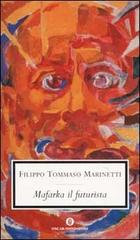 A proposito delle concezioni antimetafisiche di Marinetti, Julius Evola – che di metafisica, invece, campava – ricorderà nella sua autobiografia di quando il poeta, dopo aver letto un suo scritto, gli disse chiaro e tondo che le proprie idee erano lontane dalle sue più di quelle di un esquimese. Ma si sa, quando non si crede più nella trascendenza, si finisce spesso col credere a tutto: così fu anche per Marinetti, che come molti altri positivisti della sua epoca – pensiamo a Cesare Lombroso, e alla sua passione per i tavolini traballanti – prese a frequentare medium e spiritisti, stringendo amicizia, tra l’altro, con la sensitiva e poetessa triestina Nella Doria Cambon, confidente, per altro, anche di Svevo e di D’Annunzio.
A proposito delle concezioni antimetafisiche di Marinetti, Julius Evola – che di metafisica, invece, campava – ricorderà nella sua autobiografia di quando il poeta, dopo aver letto un suo scritto, gli disse chiaro e tondo che le proprie idee erano lontane dalle sue più di quelle di un esquimese. Ma si sa, quando non si crede più nella trascendenza, si finisce spesso col credere a tutto: così fu anche per Marinetti, che come molti altri positivisti della sua epoca – pensiamo a Cesare Lombroso, e alla sua passione per i tavolini traballanti – prese a frequentare medium e spiritisti, stringendo amicizia, tra l’altro, con la sensitiva e poetessa triestina Nella Doria Cambon, confidente, per altro, anche di Svevo e di D’Annunzio.
Ma il vitalismo di cui è pervasa l’intera opera marinettiana non è esente da influenze misticheggianti: quella di Marinetti è però una “mistica della materia”, infatti, il movimento, l’azione, il dinamismo, per Marinetti, non sono che espressioni di quell’energia bergsonianamente intesa come frutto di uno slancio vitale che spinge la materia ad evolversi. Egli stesso affermava che ogni sera era solito inginocchiarsi e pregare di fronte alla lampadina del proprio comodino, perché in essa circolava la “divina velocità”.
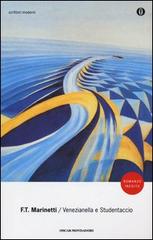 Con l’avanzar degli anni, nondimeno, farà ritorno alla fede cattolica. Negli anni ’30 promuove addirittura il movimento dell’“arte sacra futurista”, sostenendo che: «Solo gli artisti futuristi, che da vent’anni impongono nell’arte l’arduo problema della simultaneità, possono esprimere simultaneamente i dogmi simultanei del culto cattolico, come la Santa Trinità, l’Immacolata Concezione e il Calvario di Dio».
Con l’avanzar degli anni, nondimeno, farà ritorno alla fede cattolica. Negli anni ’30 promuove addirittura il movimento dell’“arte sacra futurista”, sostenendo che: «Solo gli artisti futuristi, che da vent’anni impongono nell’arte l’arduo problema della simultaneità, possono esprimere simultaneamente i dogmi simultanei del culto cattolico, come la Santa Trinità, l’Immacolata Concezione e il Calvario di Dio».
I suoi ultimi scritti, del 1944, sono “L’aeropoema di Gesù”, dove canta con enfasi palinodica «l’illusione di essere di metallo, mentre si è solo povera carne piangente», ed il “Quarto d’ora di poesia per la X Mas” – scritto poche ore prima di morire – in cui pare destreggiarsi tra il ritrovato amore per Dio e la passione per l’azione che l’accompagnò per tutta la vita: «Non vi grido arrivederci in Paradiso – dirà ai combattenti della X – ché lassù vi toccherebbe ubbidire all’infinito amore purissimo di Dio mentre voi ora smaniate dal desiderio di comandare un esercito di ragionamenti dunque autocarri avanti».
Giovanni Balducci
00:05 Publié dans art | Lien permanent | Commentaires (0) | Tags : art, avant-gardes, marinetti, futurisme, italie |  |
|  del.icio.us |
del.icio.us |  |
|  Digg |
Digg | ![]() Facebook
Facebook
lundi, 10 juin 2013
I cinquecento anni del Cavaliere ribelle
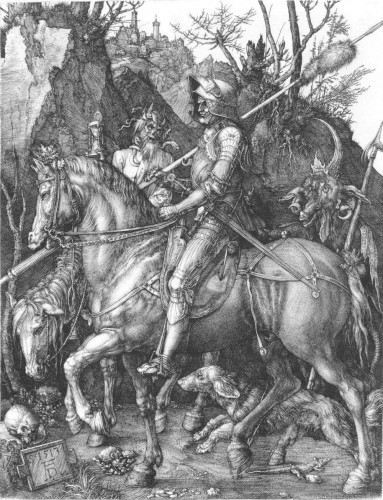
di Dominique Venner
Fonte: Barbadillo
Il Cavaliere, la Morte e il Diavolo, è la mirabile incisione realizzata da Dürer nel 1513, esattamente 500 anni fa. Il geniale artista che eseguì su commissione tantissime opere edificanti, dà qui prova d’una libertà sconcertante e audacemente provocatrice. All’epoca non era opportuno ironizzare sulla Morte e il Diavolo, terrore della brava gente e non solo, alimentato da chi ne traeva profitto. Ma lui, il Cavaliere solitario di Dürer, sorriso ironico sulle labbra, continua a cavalcare, indifferente e calmo.
Al personaggio del Diavolo non concede uno sguardo. Pertanto, questo spaventapasseri è ritenuto pericoloso. Terrore dell’epoca, come lo ricordano le innumerevoli Danze macabre e vendite delle Indulgenze per i secoli del purgatorio, il Diavolo è pronto all’imboscata. Si appropria dei trapassati per gettarli nelle fiamme dell’Inferno. Il Cavaliere se ne prende gioco e disdegna questo spettro che Dürer vuole ridicolo.
La Morte, lei, il Cavaliere la conosce. Lui sa bene che, lei, è alla fine del cammino. E allora? Cosa può su di lui, malgrado la sua clessidra vibri per ricordare lo scorrere inesorabile della vita?
Immortalato dall’incisione, il Cavaliere vivrà per sempre nel nostro immaginario al di là del tempo. Solitario, a passo fermo sul suo destriero, la spada al lato, il più celebre ribelle dell’arte occidentale cavalca tra i boschi selvaggi e i nostri pensieri sul suo destino, senza paura né supplica. Incarnazione di una figura eterna in questa parte di mondo chiamata Europa.
L’immagine dello stoico Cavaliere mi ha spesso accompagnato nelle mie rivoluzioni. E’ vero che sono un cuore ribelle e che non ho smesso d’insorgere contro la lordura invadente, contro la bassezza promossa a virtù e contro le menzogne assurte a rango di verità. Non ho smesso d’insorgere contro chi, sotto i nostri occhi ha voluto la morte dell’Europa, nostra millenaria civilizzazione, senza la quale io non sarei nulla.
(traduzione per Barbadillo.it di D.D.M.)
Note
Un ribelle del ventesimo secolo, lo scrittore Jean Cau, ha consacrato una delle sue più belle opere, Il Cavaliere, La Morte e il Diavolo, pubblicato (in Francia) dalle Edizioni della Tavola Rotonda nel 1977. Di fronte alla Morte, immagina queste parole dalla bocca del Cavaliere : “ Sono stato sognato e tu non puoi nulla contro il sogno degli uomini”.
18:49 Publié dans art, Nouvelle Droite | Lien permanent | Commentaires (0) | Tags : nouvelle droite, dominique venner, albrecht dürer, art, gravure, 16ème siècle |  |
|  del.icio.us |
del.icio.us |  |
|  Digg |
Digg | ![]() Facebook
Facebook
vendredi, 07 juin 2013
Un été au bord de l'eau
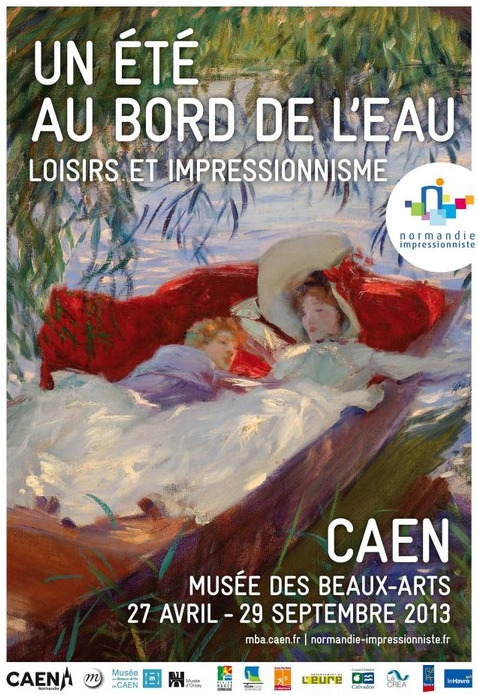
00:05 Publié dans art, Evénement | Lien permanent | Commentaires (0) | Tags : art, peinture, art plastique, caen, normandie, france, exposition, événement, impressionnisme |  |
|  del.icio.us |
del.icio.us |  |
|  Digg |
Digg | ![]() Facebook
Facebook
mercredi, 08 mai 2013
Exposition Tardi - Paris
00:05 Publié dans art, Bandes dessinées, Evénement | Lien permanent | Commentaires (0) | Tags : tardi, bandes dessinées, bd, événement, paris, france |  |
|  del.icio.us |
del.icio.us |  |
|  Digg |
Digg | ![]() Facebook
Facebook
mercredi, 17 avril 2013
Mikhail Vrubel: Mystic Painter and Russian Symbolist
00:05 Publié dans art | Lien permanent | Commentaires (0) | Tags : mikhail vrubel, russie, symbolisme, art, arts plastiques, peinture |  |
|  del.icio.us |
del.icio.us |  |
|  Digg |
Digg | ![]() Facebook
Facebook
mardi, 16 avril 2013
Konstantin Korovin Retrospective in Moscow 2012
00:05 Publié dans art | Lien permanent | Commentaires (0) | Tags : art, peinture, arts plastiques, russie, konstantin korovin |  |
|  del.icio.us |
del.icio.us |  |
|  Digg |
Digg | ![]() Facebook
Facebook
mercredi, 10 avril 2013
Conquête et abandon d’une souveraineté artistique
« Le suffrage universel ne me fait pas peur, les gens voteront comme on leur dira » disait Alexis de Tocqueville. Je poursuivrai par : l’art contemporain n’est pas à craindre, les gens aimeront comme on leur dira.
1917, irruption d’un urinoir dans un musée. La malice et la provocation de Marcel Duchamp paieront, cet objet est désormais élevé au rang d’art car marqué du sceau de l’institution. Duchamp en avant-gardiste inspiré révolutionne alors les mondes de l’art. Un bouleversement sans précédents qui marqua les jugements esthétiques, et la création contemporaine. Désormais c’est le « regardeur qui fait l’œuvre ».
Symptomatique, ce coup d’état artistique conteste le conformisme esthétique de son époque. Mais depuis, toute critique radicale est reléguée au banc des archaïsmes et autres nostalgies réactionnaires ! Mettant alors hors-jeu tout jugement esthétique. Trop souvent réduit à celui de goût, il demeure pourtant nécessaire afin de reconnaître ce qui « fait » œuvre.
Ce qui était une provocation pertinente de l’époque, quand à la forme, ne cesse pourtant d’alimenter la création d’aujourd’hui. L’anti-conformisme d’alors s’est mû en conformisme d’aujourd’hui. La subversion prend un coup de vieux et sent le réchauffé. Désormais l’absence de contraintes formelles vaudra pour liberté absolue du créateur. Sur les cimaises, les « dîtes » oeuvres rivalisent de singularités déroutantes, empêchant souvent une compréhension immédiate du message (lorsqu’il y en a un !). Mais pour qu’une oeuvre soit d’art ne faut-il pas fatalement que ses codes et qualités puissent être saisis par le commun des mortels ? Qu’elle relie l’intime à l’universel ?
Subversion et illusion
En relativisant tout jugement esthétique, nous laissons aux experts et aux institutions le soin de décider eux-mêmes de ce qui fera « oeuvre ». Le spectateur désormais privé d’outils critiques sera prié de s’en remettre à lui-même , il est alors « libre » de prendre des vessies pour des lanternes. Tout est possible lorsqu’il devient interdit de juger !
Promotion sera donc faîte à celui, qui installant une distance avec le public, prouvera qu’il est libéré de tout carcan idéologique. Les institutions, sont alors bien soucieuses d’exhiber « une expression libre« , attribut indispensable à toute vitrine sociale et démocrate. Les subversions de façade valideront ainsi à elles seules la liberté d’expression, dans ce qu’elle a de plus inoffensif. Mettre en scène plutôt que de faire vivre la démocratie de manière effective, voilà un dessein qui mérite bien des subventions !
Pourtant l’art contemporain, est avant-gardiste par définition. Il devrait contester, révéler les travers et les abus, tel le baromètre esthétique d’une société dont le peuple serait souverain. Que penser alors des « prises de risque » artistiques subventionnées ? Dénoncent-elles quelques abus de pouvoir, lorsqu’ il s’agit d’uriner sur une scène de théâtre, ou de plonger le Christ dans de la pisse ? Au pire elles choquent la ménagère, au mieux elle suscite l’indignation des sensibilités attaquées. Arguant au passage l’indétrônable liberté d’expression, comme preuve et garante de notre souveraineté !
Mais il semblerait surtout qu’il ne reste plus grand-chose à enfreindre restant politiquement correct…
Kelly Schmalz.
00:05 Publié dans art | Lien permanent | Commentaires (0) | Tags : art, art modenre, avant-garde, subversion |  |
|  del.icio.us |
del.icio.us |  |
|  Digg |
Digg | ![]() Facebook
Facebook
lundi, 01 avril 2013
Le témoignage du neveu d'Hergé
Le témoignage du neveu d'Hergé
 Le témoignage de George Rémi JUNIOR, le neveu d'Hergé, fils de son frère cadet, un militaire haut en couleur, cavalier insigne, auteur d'un manuel du parfait cavalier, est poignant, non seulement parce qu'il nous révèle un Hergé "privé", différent de celui vendu par "Moulinsart", mais aussi parce qu'il révèle bien des aspects d'une Belgique totalement révolue: sévérité de l'enseignement, difficulté pour un jeune original de se faire valoir dans son milieu parental, sauf s'il persévère dans sa volonté d'originalité (comme ce fut le cas...).
Le témoignage de George Rémi JUNIOR, le neveu d'Hergé, fils de son frère cadet, un militaire haut en couleur, cavalier insigne, auteur d'un manuel du parfait cavalier, est poignant, non seulement parce qu'il nous révèle un Hergé "privé", différent de celui vendu par "Moulinsart", mais aussi parce qu'il révèle bien des aspects d'une Belgique totalement révolue: sévérité de l'enseignement, difficulté pour un jeune original de se faire valoir dans son milieu parental, sauf s'il persévère dans sa volonté d'originalité (comme ce fut le cas...).
Sait-on notamment que le père de George Rémi junior avait été chargé d'entraîner les troupes belges à la veille de l'indépendance congolaise? Et qu'il a flanqué des officiers américains et onusiens, manu militari, à la porte de son camp qui devait être rendu aux Congolais au nom des grands principes de la décolonisation?
Le témoignage du fils rebelle, opposé à son père, se mue en une tendresse magnifique quand la mort rôde et va emporter la vie du fringant officier de cavalerie, assagi par l'âge et heureux que son fiston soit devenu un peintre de marines reconnus et apprécié. George Rémi Junior n'est pas tendre pour son oncle, certes, mais il avoue toute de même, à demi mot, qu'il en a fait voir des vertes et des pas mûres au créateur de Tintin.
Mais l'homme qui en prend plein son grade, dans ce témoignagne, n'est pas tant Hergé: c'est plutôt l'héritier du formidable empire hergéen, l'époux de la seconde épouse d'Hergé. George Rémi Junior entre dans de véritables fureurs de Capitaine Haddock quand il évoque cette figure qui, quoi qu'on en pense, gère toute de même bien certains aspects de l'héritage hergéen, avec malheureusement, une propension à froisser cruellement des amis sincères de l'oeuvre de George Rémi Senior comme le sculpteur Aroutcheff, Stéphane Steeman (qui a couché ses griefs sur le papier...), les Amis d'Hergé et leur sympathique revue semestrielle. Dommage et navrant: une gestion collégiale de l'héritage par tous ceux qui ne veulent en rien altérer la ligne claire et surtout le message moral qui se profile derrière le héros de papier aurait été bien plus profitable à tous...
George Rémi Junior rend aussi justice à Germaine Kiekens, la première épouse, l'ancienne secrétaire de l'Abbé Wallez, directeur du quotidien catholique "Le Vingtième Siècle", là tout avait commencé...
(RS)
George Rémi Jr, Un oncle nommé Hergé, Ed. Archipel, Paris, 2013 (Préface de Stéphane Steeman).
00:05 Publié dans art, Bandes dessinées, Belgicana, Biographie | Lien permanent | Commentaires (1) | Tags : art, ligne claire, 9ème art, hergé, tintin, tintinophilie, biographie, témoignage, belgicana, belgique |  |
|  del.icio.us |
del.icio.us |  |
|  Digg |
Digg | ![]() Facebook
Facebook
mardi, 12 mars 2013
Plongée dans le neuvième art
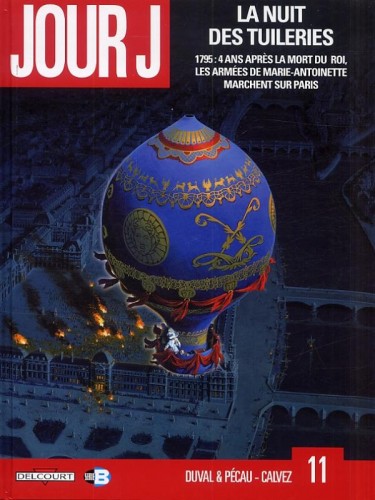
Plongée dans le neuvième art
par Rodolphe BADINAND
Le festival annuel de bandes dessinées d’Angoulême s’est terminé depuis quelques semaines dans un quant-à-soi convenu qui entérine la massification grandissante du neuvième art. La ligne claire valorisée par les auteurs franco-belges des journaux concurrents Tintin et Spirou a été abandonnée au profit de dessins souvent grotesques, difformes, inesthétiques et surchargés de couleurs criardes. Quant aux récits, ils sont répétitifs, inintéressants et sans beaucoup d’imagination. Néanmoins, dans le foisonnement éditorial émergent quelques albums détonnants.
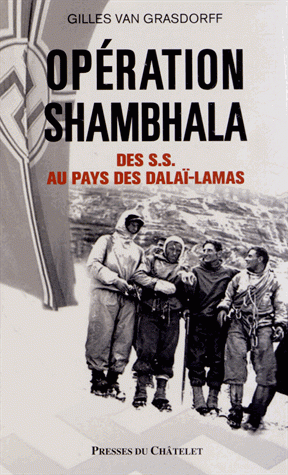 L’énigmatique Jacques Bergier est l’un des héros principaux d’une série, au succès indéniable, qui en est à son deuxième volume : Wunderwaffen. Si l’histoire concerne toujours le second conflit planétaire, les événements sont uchroniques. Le 6 juin 1944, les mauvaises conditions météo et la réaction plus rapide des Allemands empêchent le débarquement allié en Normandie. La guerre se prolonge donc au-delà de 1945 même si les États-Unis ont mis un terme à la guerre dans le Pacifique au moyen des bombes atomiques. L’Allemagne résiste grâce à la généralisation de ses armes secrètes, les « armes-miracles » : V1, V2, V3, avions monoplans à réaction… Victime d’un nouvel attentat, le 8 mai 1945, qui l’a en partie défiguré et privé d’un bras, Hitler se verra bientôt doté d’un membre supérieur artificiel.
L’énigmatique Jacques Bergier est l’un des héros principaux d’une série, au succès indéniable, qui en est à son deuxième volume : Wunderwaffen. Si l’histoire concerne toujours le second conflit planétaire, les événements sont uchroniques. Le 6 juin 1944, les mauvaises conditions météo et la réaction plus rapide des Allemands empêchent le débarquement allié en Normandie. La guerre se prolonge donc au-delà de 1945 même si les États-Unis ont mis un terme à la guerre dans le Pacifique au moyen des bombes atomiques. L’Allemagne résiste grâce à la généralisation de ses armes secrètes, les « armes-miracles » : V1, V2, V3, avions monoplans à réaction… Victime d’un nouvel attentat, le 8 mai 1945, qui l’a en partie défiguré et privé d’un bras, Hitler se verra bientôt doté d’un membre supérieur artificiel. Avec La nuit des Tuileries, la royauté française est au cœur du n° 11, récemment sorti. L’uchronie commence dans la nuit du 10 juin 1791. Des sans-culottes exaltés se dirigent sur les Tuileries, mais la famille royale parvient à s’en échapper en montgolfière. Or, au moment de l’ascension, une balle atteint le ventre de Louis XVI qui meurt en chemin. Le Dauphin devient le nouveau roi et sa mère, la reine Marie-Antoinette, la régente. Celle-ci anime l’« Armée des Princes » et la France sombre dans une terrible guerre civile. En 1795, l’armée royale, dirigée par un génial général d’origine corse, ancien mercenaire au service du Grand Turc, est aux portes de Paris, bastion sans-culotte chauffé à blanc par Robespierre. Mais Danton négocie en secret avec l’évêque d’Autun, Talleyrand, afin de rétablir la royauté dans un cadre constitutionnel.
Avec La nuit des Tuileries, la royauté française est au cœur du n° 11, récemment sorti. L’uchronie commence dans la nuit du 10 juin 1791. Des sans-culottes exaltés se dirigent sur les Tuileries, mais la famille royale parvient à s’en échapper en montgolfière. Or, au moment de l’ascension, une balle atteint le ventre de Louis XVI qui meurt en chemin. Le Dauphin devient le nouveau roi et sa mère, la reine Marie-Antoinette, la régente. Celle-ci anime l’« Armée des Princes » et la France sombre dans une terrible guerre civile. En 1795, l’armée royale, dirigée par un génial général d’origine corse, ancien mercenaire au service du Grand Turc, est aux portes de Paris, bastion sans-culotte chauffé à blanc par Robespierre. Mais Danton négocie en secret avec l’évêque d’Autun, Talleyrand, afin de rétablir la royauté dans un cadre constitutionnel.
Article printed from Europe Maxima: http://www.europemaxima.com
URL to article: http://www.europemaxima.com/?p=2979
00:05 Publié dans art, Bandes dessinées | Lien permanent | Commentaires (0) | Tags : art, 9ème art, bande dessinée |  |
|  del.icio.us |
del.icio.us |  |
|  Digg |
Digg | ![]() Facebook
Facebook
dimanche, 17 février 2013
Some Sort of Nietzschean
Some Sort of Nietzschean
By Alex Kurtagić
Ex: http://www.counter-currents.com/
Review:
Paul O’Keefe
Some Sort of Genius: A Life of Wyndham Lewis [2]
London: Pimlico, 2000
In his acknowledgment pages Paul O’Keefe states that it took him a decade—not including the years of research already donated to him by another writer—to complete his biography of Wyndham Lewis, a project he began in 1990 while he was president of the Wyndham Lewis Society. And this is apparent, for this volume, holding 700 pages of tightly packed print, offers an indefatigably detailed and masochistically researched account of the British modernist artist and author’s life.
Biographies differ in emphasis, depending on the author’s biases, and the tone here is set early in the first chapter, which consists of a detailed description of Lewis’ bisected brain—now preserved in the Pathology Museum of the Imperial College School of Medicine—and the progressive destruction (through compression of the adjacent structures) caused by the growth of its pituitary tumor, medically known as a chromophone adenoma. O’Keefe’s narration is temperate and balanced in the extreme, abstaining from either celebration or condemnation, or indeed evaluation, of his subject. Instead, we are presented with unvarnished facts and restrained descriptions of circumstances, and, where records have not survived or never existed and witness memories were unavailable, with the most disciplined of inference.
Initially, the effect of this cold detective approach is a certain literary anhedonia: the narrative barely raises the pulse, despite Lewis’ turbulent social life, truculence, and extraordinarily difficult personality. One feels that another author would have been able to produce much more dramatic prose with the same information.
All the same, O’Keefe’s biography is impressive, and after a somewhat laborious account of Lewis’ Bohemian early life and career—which, ironically, includes his most significant artistic period, coinciding with Cubism and Futurism, and now referred to as Vorticist—the pace picks up once we get to 1930, the year Apes of God (London: Arthur Press, 1930), Lewis’ savage satire of London’s literary scene and the Bloomsbury Group, was published. We learn, as we race through the decade, that Lewis would routinely ridicule his friends and patrons in his novels, where they would appear thinly disguised under a pseudonym. Few were spared, which led to many a falling out, libel writs, and loss of patronage. This, plus Lewis’ quarrelsome, irascible, ultra-individualistic, cruel, secretive, litigious, and somewhat paranoid personality, kept him always on the verge of bankruptcy, despite his tremendous creative energy and productivity. Indeed, when a group of friends decided to contribute monthly to a fund so that Lewis could work without financial worries—for he was always in arrears and in debt—he very quickly and rudely alienated his benefactors. This was probably because he resented being beholden to anyone. Any well-meaning gesture was an affront.
The book is hard to put down as we pass through the 1940s. From the late 1930s, when Lewis travelled to North America, where he alternated between Canada and the United States and where he remained until after the end of the war. There we are taken to what was probably the most bitter and penurious period in his life. By this time he had difficulties finding a publisher, having become notorious for attracting libel suits, locking horns with his earlier publishers, and not delivering manuscripts for which he had been paid an advance. In the United States his books were deemed by some not the most marketable. Commissions for portraits and other art, which he desperately needed and assiduously sought, were scarce and not proof against upsetting his patrons. They were also not terribly popular—in 1938 his portrait of T. S. Eliot had been rejected by the Royal Academy [3]. And speaking engagements, greatly facilitated by the publicity efforts of friend and future media guru Marshall McLuhan, proved insufficient and disappointing financially—Lewis was no Jonathan Bowden, in any event. Thus, he and his wife survived in cheap hotels and grim rented accommodation only a dollar, sometimes a few cents, away from eviction until 1945.
Lewis’ situation improved marginally thereafter, though by this time his eyesight was in steep decline, owing to his as-yet-undiagnosed pituitary tumor compressing his optic nerve. His 1949 portrait of T. S. Eliot would be his last painting. All the same, Lewis marched on, continuing to author substantial and difficult books—including the last two volumes of his Human Age trilogy, the first of which had been published many years earlier—even after he went blind in 1951. In his final years, Lewis benefited from the radio dramatisation of his trilogy and from his Civil List Pension, which, though exiguous, provided him with a bare minimum of security.
O’Keefe’s narration continues through to a search of Lewis’ condemned flat soon after his death and to his final resting place inside a niche in a wall at Golder’s Green Crematorium.
Despite its comprehensiveness in all that pertains to Lewis, O’Keefe’s biography has two major deficiencies, which stem from the fact that all we learn is tightly circumscribed to the facts and events relating to Lewis and his immediate social periphery. Firstly, aside from a few clinical descriptions, we learn very little about Lewis’ art and writing, or their cultural significance. By the time he finally receives a modicum of institutional honors and recognition, it comes almost unexpectedly; it is as if there had been a sudden sea change and the invisible powers who had previously been critical, suspicious, or unimpressed suddenly decided to relent. Secondly, there is virtually no wider historical, cultural, or sociological context, leaving Lewis’ life and work somewhat abstracted; the points of reference appear shadowy, remote, and somewhat peremptory. One can go too far in the opposite direction, of course, which would detract from a work that aims to be objective, devoid of opinion and coloration, or about an individual as opposed to his times, but it seems O’Keefe was a little too careful to avoid this.
We do obtain some perspective through Lewis’ relations with (and on occasion anecdotes involving some of) the various and now illustrious members of Lewis’ circle—which included Ezra Pound, T. S. Eliot, James Joyce, D. H. Lawrence, and W. B. Yeats—but this perspective remains somewhat shallow, and the individuals concerned remain somewhat distant. This may well be because Lewis was a study in detachment; we learn that for him friends were there to be used, and were friends only in so much as they were useful. Bowden described him [4] as “a bit of a rogue” and “a rascal,” and one can see why.
Having said that, in this biography Lewis does not come across as the iron-hard Right-winger that Bowden made him out to be. It is admitted that Lewis wrote a book called Hitler (London: Chatto and Windus, 1931), but he wrote it hastily and it seems he later regretted it, writing The Hitler Cult and How It Will End (London: J. M. Dent and Sons Ltd., 1939) and The Jews: Are They Human? (London: George Allen and Unwin, 1939), the latter of which is an attack against anti-Semitism. (O’Keefe also documents the frustration with Lewis of German National Socialists visiting the United Kingdom in the early 1930s in the face of the British author’s refusal to identify Communists as Jews—although this may have been recalcitrant individualism on the part of Lewis, for an anecdote a few hundred pages later on in the biography suggests he was aware of the “Jewish question,” a state not necessarily incompatible with dismissing anti-Semitism as “a racial red-herring.”)
It is admitted that Lewis met William Joyce and Oswald Mosley (O’Keefe, p. 370), but any relations in this biography appear vague and non-committal, his article in the British Union Quarterly notwithstanding. It is admitted also that, he wrote two other books (Left Wings Over Europe [London: Jonathan Cape, 1936] and Count Your Dead: They Are Alive! [London: Lovat Dickson, 1937]) which have been interpreted as in support for Mussolini and Franco respectively, but they are anti-war tracts. Later, Lewis would write Anglo-Saxony: A League that Works (Toronto: Ryerson, 1941), which is pro-democracy, and America and Cosmic Man (New York: Doubleday Company, 1949), where he pledges allegiance to a cosmic or cosmopolitan utopianism (Cosmic Man, p. 238).
Lewis’ politics were complex. Not Red, certainly, but not pure Black either. Now, Bowden, who knew O’Keefe for a time, described the latter as a liberal, and told in his 2006 talk about Lewis how, while being a member of the Wyndham Lewis Society, he told those present at an AGM that the society was “based on a lie”—proceeding then to accuse its members of revisionism, timidity, and denial. It may be that Bowden saw in Lewis want he wanted to see, or that his interpretation of Lewis as a Nietzschean metapolitical fascist owed to Bowden’s approaching his subject as a Nietzschean and a Stirnerite. Or that he focused only on the parts of Lewis that interested him, obviously the inter-war and then the late period.
In O’Keefe’s biography, certainly, Nietzsche does not figure in relation to Lewis. This is not to say, however, that Lewis was not a Nietzschean force or cannot be seen as such: aside from what can be gleaned from his prose or the conceptual elitism of his 1917 manifesto (“The Code of a Herdsman”), Lewis was certainly always against, always difficult and “rebarbative,” and always—despite his navigating a fairly wide circle of leading modernist artists and literati, alone against all, unabated by poverty and refusing to throw in the towel even after he went blind.
The reason for the above remarks is that I read this book as background research for a biography of Jonathan Bowden. Bowden mentioned Lewis frequently in his early writing, and among his effects after his death several books by Lewis were found, including Childermass (London: Chatto and Windus, 1928), The Revenge of Love (London: Cassell and Co. 1937), Self Condemned (London: Methuen Press, 1954), Apes of God, Snooty Baronet (London: Cassell and Co., 1932), Tarr (New York: Alfred A. Knopf, 1918; London: Chatto and Windus, 1928), and The Demon of Progress in the Arts (London: Methuen Press, 1954).
From the present biography of Lewis one can easily see the reasons why Bowden could have conceivably either identified with or seen something of himself in Lewis. Both lost a parent in early life. Both were prolific painters and writers, both of an experimental sort, though Bowden more than Lewis. Both identified with the politics of the Right, while also being aggressively individualistic, though, again, Bowden more than Lewis. Both were unafraid of—and indeed enjoyed—including friends and acquaintances in their prose, where these victims of cruel and often libellous psychoanalysis appeared quasi-cartoonified and only thinly disguised under pseudonyms. Both moved frequently during early adulthood and later lived closed off, hidden away at a recondite and obscure address. Both were secretive in their personal lives, which they strictly compartmentalized—in Lewis’ case, many of his friends were unaware of the fact that he had a wife and several children (by previous lovers) until Lewis was in late middle age; initially, he never mentioned her, few ever saw her, and no one was ever given access to the flat hidden behind a door below his studio, where she lived with him, until many years later. Both found wealth elusive, and were mostly interested in recognition. And there are other parallels. On the whole, however, Bowden was more consistent philosophically, harder politically, and a more extreme artist and writer.
Irrespective of your thoughts on modernism in general, Wyndham Lewis is sufficiently interesting on his own for this major biography to be educational and entertaining, though I suspect it will be those familiar with Jonathan Bowden’s oratory who will get the greater profit.
Article printed from Counter-Currents Publishing: http://www.counter-currents.com
URL to article: http://www.counter-currents.com/2013/02/some-sort-of-nietzschean/
00:05 Publié dans art, Littérature | Lien permanent | Commentaires (0) | Tags : wyndham lewis, art, avant-garde, angleterre, lettres, lettres anglaises, littérature, littérature anglaise |  |
|  del.icio.us |
del.icio.us |  |
|  Digg |
Digg | ![]() Facebook
Facebook
lundi, 11 février 2013
The Comic Book as Linear Energy

The Comic Book as Linear Energy
By Jonathan Bowden
Ex: http://www.counter-currents.com/
Edited by Alex Kurtagić
Editor’s Note:
The following is excerpted from a book called Scum, written in 1992. It is part of a larger and wide-ranging, if perhaps unfocused, discussion on sado-masochism and the expulsion and conservation of energy. The text has only been lightly edited for punctuation, spelling, capitalisation, and grammar.
One of the most interesting and despised areas of popular culture is the “funny book” or comic—although the comic book itself has now become a prized form, with the original frames of Batman and Superman fetching large prices at Sotheby’s and other art dealers. The early comics, such as Batman and Superman, were staples of DC comics, based in the Rockefeller Plaza. They were adventure stories for boys, though comics were later to split along the styles of gender specification, and boys enjoyed superhero comics, perhaps War and Battle as well, while girls tended towards romantic comics dealing , in a crude way, with “human situations,” such as Cindy magazine. One can almost hear feminist devotees clucking in the background, but gender specification is an inalienable fact, a biological reality.
Nevertheless, Batman and Superman were subtly different from each other, and while Superman was more rugged, more all-American, Batman was darker and had more Gothic potential. Indeed, Batman was a mere mortal, unlike Superman, an expression of the vigilante urge in American society. In accordance with liberal stereotypes, of course, Batman was an individual who liked dressing in sado-masochistic uniforms and “beating the hell out of criminals.” He was obviously a man who showed “fascistic symptoms“—elements of pathological retribution, based on the murder of his parents, the Waynes. While Batman himself represented a dark, Gothic atmosphere, his villains, who reappeared in issue after issue, were his alter egos. Moreover, they appeared to be necessarily lightweight; they were villains of humor, charlatans of deviousness, like the Joker, the Riddler, and the Penguin.
The Joker is an interesting figure: a man who always murders his opponents with a smile on his face. This is basically because the smile, the broken leer, is unmovable; it was fixed there either by acid or a radioactive explosion, I cannot remember which—but, unlike Doctor Doom, the villain in The Fantastic Four, a Marvel comic which came along later, the Joker is not a genuinely tragic figure.
Doctor Doom, on the other hand, is a marvelous character, a man who has been terribly disfigured by a chemical explosion. As a result of this, he locks his face and eventually his whole body away in a suit of armour, later covered with beige cloth. Like The Phantom of the Opera in Gaston Leroux’s novel, no-one can see his face without being completely incapacitated—one of the reasons why it has never been shown in a comic panel.
In a sense, therefore, comic books represent orgies of violence, ugliness, meaninglessness, and sado-masochistic violence. Indeed, it is not surprising that Marvel Comics later introduced a character called The Punisher, first as a villain in Spiderman, and then as a hero or anti-hero in his own strip.
Marvel also brought out a highly sophisticated and degenerate comic called Deathlok, which featured a strange freak of science fiction: a half-human robot; a robot which was actually a reanimated and rotting corpse—the corpse of a marine commando, held in a metal casing and with part of its brain replaced by a computer (‘puter), with which the cyborg engaged in constant mental jousts.
As can be seen from the above, these comics were an amphitheatre of perversion, a cruel tourney, available in any dime house, over which children would pore for hours, much to the consternation of their parents. Not surprisingly, there are periodic attempts (by parents and guardian committees, watchdogs, and so forth) to ban or restrict the circulation of such material, and under threat by a Congressional committee that was concerned about “horror comics,” the industry bowed to the inevitable and introduced a voluntary body, the Comics Code Authority.
Of course, the whole purpose of comic books is that they are cruel “jokes,” violent forms of juvenilia, which focus and dispel the raw emotions of children. In a sense they are the violent fantasies of children, where no-one is ever hurt and everyone picks themselves up at the end of the day. Hence, we see the purposeless energy, the violent and contrary lines of force that comic books represent. They are festivals of line, disorientated patterns of force—just look at the Modesty Blaise strip by Peter O’Donnell, for instance, and you will realize that they are the sine qua non of Right-wing art. They are a festival of linear force—nothingness, despair, redemption, where redemption involves commitment, in the Sartrean sense, nearly always through violent action. This is the type of act represented by Rapeman in the Japanese adult comics known as Manga, where beautiful and dreamy oriental women, drawn in outline, are sexually assaulted and murdered by Rapeman. Moreover, such draughtmanship always accentuates the sexual organs of women, as in the Vampirella strip, for example.
The Vampirella strip, in particular, dealt with the adventures of a scantily clad Transylvanian countess. In many respects, it was an attempt to corner two markets at once: namely, the market for horror stories, on the one hand, and the market for soft pornography, on the other. Moreover, you can be sure such comics were not licensed by the Comics’ Code Authority.
http://www.wermodandwermod.com/newsitems/news020220131828.html [2]
Article printed from Counter-Currents Publishing: http://www.counter-currents.com
URL to article: http://www.counter-currents.com/2013/02/the-comic-book-as-linear-energy/
00:04 Publié dans art, Bandes dessinées, Nouvelle Droite | Lien permanent | Commentaires (0) | Tags : jonathan bowden, bande dessinée, art, 9ème art, nouvelle droite britannique |  |
|  del.icio.us |
del.icio.us |  |
|  Digg |
Digg | ![]() Facebook
Facebook



